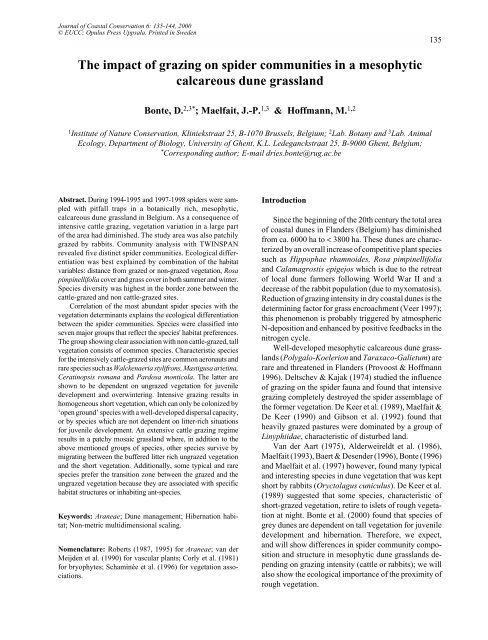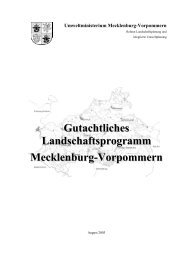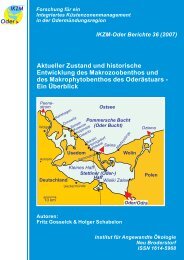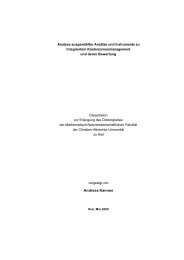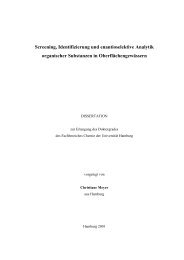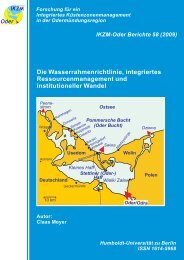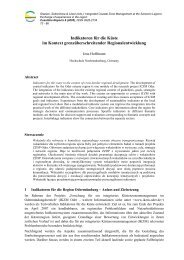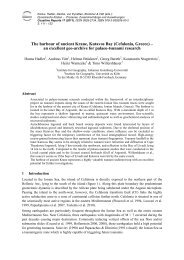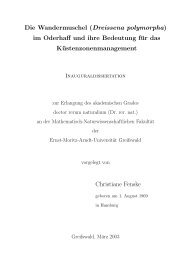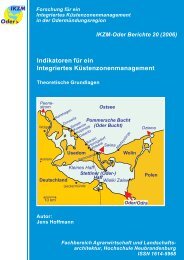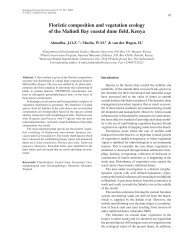The impact of grazing on spider communities in a mesophytic ...
The impact of grazing on spider communities in a mesophytic ...
The impact of grazing on spider communities in a mesophytic ...
Create successful ePaper yourself
Turn your PDF publications into a flip-book with our unique Google optimized e-Paper software.
Journal <str<strong>on</strong>g>of</str<strong>on</strong>g> Coastal C<strong>on</strong>servati<strong>on</strong> 6: 135-144, 2000<br />
© EUCC; Opulus Press Uppsala. Pr<strong>in</strong>ted <strong>in</strong> Sweden<br />
- <str<strong>on</strong>g>The</str<strong>on</strong>g> <str<strong>on</strong>g>impact</str<strong>on</strong>g> <str<strong>on</strong>g>of</str<strong>on</strong>g> <str<strong>on</strong>g>graz<strong>in</strong>g</str<strong>on</strong>g> <strong>on</strong> <strong>spider</strong> <strong>communities</strong> <strong>in</strong> a <strong>mesophytic</strong> calcareous dune grasslands - 135<br />
<str<strong>on</strong>g>The</str<strong>on</strong>g> <str<strong>on</strong>g>impact</str<strong>on</strong>g> <str<strong>on</strong>g>of</str<strong>on</strong>g> <str<strong>on</strong>g>graz<strong>in</strong>g</str<strong>on</strong>g> <strong>on</strong> <strong>spider</strong> <strong>communities</strong> <strong>in</strong> a <strong>mesophytic</strong><br />
calcareous dune grassland<br />
B<strong>on</strong>te, D. 2,3* ; Maelfait, J.-P. 1,3 & H<str<strong>on</strong>g>of</str<strong>on</strong>g>fmann, M. 1,2<br />
1 Institute <str<strong>on</strong>g>of</str<strong>on</strong>g> Nature C<strong>on</strong>servati<strong>on</strong>, Kl<strong>in</strong>iekstraat 25, B-1070 Brussels, Belgium; 2 Lab. Botany and 3 Lab. Animal<br />
Ecology, Department <str<strong>on</strong>g>of</str<strong>on</strong>g> Biology, University <str<strong>on</strong>g>of</str<strong>on</strong>g> Ghent, K.L. Ledeganckstraat 25, B-9000 Ghent, Belgium;<br />
* Corresp<strong>on</strong>d<strong>in</strong>g author; E-mail dries.b<strong>on</strong>te@rug.ac.be<br />
Abstract. Dur<strong>in</strong>g 1994-1995 and 1997-1998 <strong>spider</strong>s were sampled<br />
with pitfall traps <strong>in</strong> a botanically rich, <strong>mesophytic</strong>,<br />
calcareous dune grassland <strong>in</strong> Belgium. As a c<strong>on</strong>sequence <str<strong>on</strong>g>of</str<strong>on</strong>g><br />
<strong>in</strong>tensive cattle <str<strong>on</strong>g>graz<strong>in</strong>g</str<strong>on</strong>g>, vegetati<strong>on</strong> variati<strong>on</strong> <strong>in</strong> a large part<br />
<str<strong>on</strong>g>of</str<strong>on</strong>g> the area had dim<strong>in</strong>ished. <str<strong>on</strong>g>The</str<strong>on</strong>g> study area was also patchily<br />
grazed by rabbits. Community analysis with TWINSPAN<br />
revealed five dist<strong>in</strong>ct <strong>spider</strong> <strong>communities</strong>. Ecological differentiati<strong>on</strong><br />
was best expla<strong>in</strong>ed by comb<strong>in</strong>ati<strong>on</strong> <str<strong>on</strong>g>of</str<strong>on</strong>g> the habitat<br />
variables: distance from grazed or n<strong>on</strong>-grazed vegetati<strong>on</strong>, Rosa<br />
pimp<strong>in</strong>ellifolia cover and grass cover <strong>in</strong> both summer and w<strong>in</strong>ter.<br />
Species diversity was highest <strong>in</strong> the border z<strong>on</strong>e between the<br />
cattle-grazed and n<strong>on</strong> cattle-grazed sites.<br />
Correlati<strong>on</strong> <str<strong>on</strong>g>of</str<strong>on</strong>g> the most abundant <strong>spider</strong> species with the<br />
vegetati<strong>on</strong> determ<strong>in</strong>ants expla<strong>in</strong>s the ecological differentiati<strong>on</strong><br />
between the <strong>spider</strong> <strong>communities</strong>. Species were classified <strong>in</strong>to<br />
seven major groups that reflect the species' habitat preferences.<br />
<str<strong>on</strong>g>The</str<strong>on</strong>g> group show<strong>in</strong>g clear associati<strong>on</strong> with n<strong>on</strong> cattle-grazed, tall<br />
vegetati<strong>on</strong> c<strong>on</strong>sists <str<strong>on</strong>g>of</str<strong>on</strong>g> comm<strong>on</strong> species. Characteristic species<br />
for the <strong>in</strong>tensively cattle-grazed sites are comm<strong>on</strong> aer<strong>on</strong>auts and<br />
rare species such as Walckenaeria stylifr<strong>on</strong>s, Mastigusa ariet<strong>in</strong>a,<br />
Cerat<strong>in</strong>opsis romana and Pardosa m<strong>on</strong>ticola. <str<strong>on</strong>g>The</str<strong>on</strong>g> latter are<br />
shown to be dependent <strong>on</strong> ungrazed vegetati<strong>on</strong> for juvenile<br />
development and overw<strong>in</strong>ter<strong>in</strong>g. Intensive <str<strong>on</strong>g>graz<strong>in</strong>g</str<strong>on</strong>g> results <strong>in</strong><br />
homogeneous short vegetati<strong>on</strong>, which can <strong>on</strong>ly be col<strong>on</strong>ized by<br />
‘open ground’ species with a well-developed dispersal capacity,<br />
or by species which are not dependent <strong>on</strong> litter-rich situati<strong>on</strong>s<br />
for juvenile development. An extensive cattle <str<strong>on</strong>g>graz<strong>in</strong>g</str<strong>on</strong>g> regime<br />
results <strong>in</strong> a patchy mosaic grassland where, <strong>in</strong> additi<strong>on</strong> to the<br />
above menti<strong>on</strong>ed groups <str<strong>on</strong>g>of</str<strong>on</strong>g> species, other species survive by<br />
migrat<strong>in</strong>g between the buffered litter rich ungrazed vegetati<strong>on</strong><br />
and the short vegetati<strong>on</strong>. Additi<strong>on</strong>ally, some typical and rare<br />
species prefer the transiti<strong>on</strong> z<strong>on</strong>e between the grazed and the<br />
ungrazed vegetati<strong>on</strong> because they are associated with specific<br />
habitat structures or <strong>in</strong>habit<strong>in</strong>g ant-species.<br />
Keywords: Araneae; Dune management; Hibernati<strong>on</strong> habitat;<br />
N<strong>on</strong>-metric multidimensi<strong>on</strong>al scal<strong>in</strong>g.<br />
Nomenclature: Roberts (1987, 1995) for Araneae; van der<br />
Meijden et al. (1990) for vascular plants; Corly et al. (1981)<br />
for bryophytes; Scham<strong>in</strong>ée et al. (1996) for vegetati<strong>on</strong> associati<strong>on</strong>s.<br />
Introducti<strong>on</strong><br />
S<strong>in</strong>ce the beg<strong>in</strong>n<strong>in</strong>g <str<strong>on</strong>g>of</str<strong>on</strong>g> the 20th century the total area<br />
<str<strong>on</strong>g>of</str<strong>on</strong>g> coastal dunes <strong>in</strong> Flanders (Belgium) has dim<strong>in</strong>ished<br />
from ca. 6000 ha to < 3800 ha. <str<strong>on</strong>g>The</str<strong>on</strong>g>se dunes are characterized<br />
by an overall <strong>in</strong>crease <str<strong>on</strong>g>of</str<strong>on</strong>g> competitive plant species<br />
such as Hippophae rhamnoides, Rosa pimp<strong>in</strong>ellifolia<br />
and Calamagrostis epigejos which is due to the retreat<br />
<str<strong>on</strong>g>of</str<strong>on</strong>g> local dune farmers follow<strong>in</strong>g World War II and a<br />
decrease <str<strong>on</strong>g>of</str<strong>on</strong>g> the rabbit populati<strong>on</strong> (due to myxomatosis).<br />
Reducti<strong>on</strong> <str<strong>on</strong>g>of</str<strong>on</strong>g> <str<strong>on</strong>g>graz<strong>in</strong>g</str<strong>on</strong>g> <strong>in</strong>tensity <strong>in</strong> dry coastal dunes is the<br />
determ<strong>in</strong><strong>in</strong>g factor for grass encroachment (Veer 1997);<br />
this phenomen<strong>on</strong> is probably triggered by atmospheric<br />
N-depositi<strong>on</strong> and enhanced by positive feedbacks <strong>in</strong> the<br />
nitrogen cycle.<br />
Well-developed <strong>mesophytic</strong> calcareous dune grasslands<br />
(Polygalo-Koeleri<strong>on</strong> and Taraxaco-Galietum) are<br />
rare and threatened <strong>in</strong> Flanders (Provoost & H<str<strong>on</strong>g>of</str<strong>on</strong>g>fmann<br />
1996). Deltschev & Kajak (1974) studied the <strong>in</strong>fluence<br />
<str<strong>on</strong>g>of</str<strong>on</strong>g> <str<strong>on</strong>g>graz<strong>in</strong>g</str<strong>on</strong>g> <strong>on</strong> the <strong>spider</strong> fauna and found that <strong>in</strong>tensive<br />
<str<strong>on</strong>g>graz<strong>in</strong>g</str<strong>on</strong>g> completely destroyed the <strong>spider</strong> assemblage <str<strong>on</strong>g>of</str<strong>on</strong>g><br />
the former vegetati<strong>on</strong>. De Keer et al. (1989), Maelfait &<br />
De Keer (1990) and Gibs<strong>on</strong> et al. (1992) found that<br />
heavily grazed pastures were dom<strong>in</strong>ated by a group <str<strong>on</strong>g>of</str<strong>on</strong>g><br />
L<strong>in</strong>yphiidae, characteristic <str<strong>on</strong>g>of</str<strong>on</strong>g> disturbed land.<br />
Van der Aart (1975), Alderweireldt et al. (1986),<br />
Maelfait (1993), Baert & Desender (1996), B<strong>on</strong>te (1996)<br />
and Maelfait et al. (1997) however, found many typical<br />
and <strong>in</strong>terest<strong>in</strong>g species <strong>in</strong> dune vegetati<strong>on</strong> that was kept<br />
short by rabbits (Oryctolagus cuniculus). De Keer et al.<br />
(1989) suggested that some species, characteristic <str<strong>on</strong>g>of</str<strong>on</strong>g><br />
short-grazed vegetati<strong>on</strong>, retire to islets <str<strong>on</strong>g>of</str<strong>on</strong>g> rough vegetati<strong>on</strong><br />
at night. B<strong>on</strong>te et al. (2000) found that species <str<strong>on</strong>g>of</str<strong>on</strong>g><br />
grey dunes are dependent <strong>on</strong> tall vegetati<strong>on</strong> for juvenile<br />
development and hibernati<strong>on</strong>. <str<strong>on</strong>g>The</str<strong>on</strong>g>refore, we expect,<br />
and will show differences <strong>in</strong> <strong>spider</strong> community compositi<strong>on</strong><br />
and structure <strong>in</strong> <strong>mesophytic</strong> dune grasslands depend<strong>in</strong>g<br />
<strong>on</strong> <str<strong>on</strong>g>graz<strong>in</strong>g</str<strong>on</strong>g> <strong>in</strong>tensity (cattle or rabbits); we will<br />
also show the ecological importance <str<strong>on</strong>g>of</str<strong>on</strong>g> the proximity <str<strong>on</strong>g>of</str<strong>on</strong>g><br />
rough vegetati<strong>on</strong>.
136 B<strong>on</strong>te, D. et al.<br />
Material and Methods<br />
Study area<br />
Data were collected <strong>in</strong> a dune area at Oostdu<strong>in</strong>kerke<br />
(Koksijde, West Flanders, Belgium), which was formed<br />
<strong>in</strong> the 11th century as a spit <str<strong>on</strong>g>of</str<strong>on</strong>g> sandy dunes <strong>in</strong> the IJzerestuary.<br />
Due to eolic processes, an undulat<strong>in</strong>g landscape<br />
(kopjesdu<strong>in</strong>) was formed (Provoost & H<str<strong>on</strong>g>of</str<strong>on</strong>g>fmann 1996).<br />
<str<strong>on</strong>g>The</str<strong>on</strong>g> area has probably been used as pasture by local<br />
farmers for centuries (H<str<strong>on</strong>g>of</str<strong>on</strong>g>fmann et al. 1998). This land<br />
use, <strong>in</strong> comb<strong>in</strong>ati<strong>on</strong> with a lime-rich soil, has resulted <strong>in</strong><br />
floristically rich dune grassland.<br />
<str<strong>on</strong>g>The</str<strong>on</strong>g> northwestern part <str<strong>on</strong>g>of</str<strong>on</strong>g> the area is <strong>in</strong>tensively<br />
grazed by cattle from May till October (2 - 3 cows/ ha). As<br />
a result vegetati<strong>on</strong> height rarely exceeds 10 cm. It is ma<strong>in</strong>ly<br />
dom<strong>in</strong>ated by mosses (e.g. Tortula ruralis ssp. ruraliformis,<br />
Hypnum cupressiforme var. lacunosum), low scattered<br />
grasses (e.g. Poa pratensis, Agrostis capillaris), sedges<br />
(e.g. Carex arenaria) and <strong>mesophytic</strong> herbs (e.g. Galium<br />
verum, Asperula cynanchica, Helianthemum nummularium,<br />
Potentilla neumanniana and Rumex acetosella). No nitrogen<br />
fertilizati<strong>on</strong> takes place. <str<strong>on</strong>g>The</str<strong>on</strong>g> rema<strong>in</strong><strong>in</strong>g part <str<strong>on</strong>g>of</str<strong>on</strong>g> the<br />
area has, <strong>in</strong> part, been grazed by cattle or horses <strong>in</strong> the<br />
past but recently has been grazed <strong>on</strong>ly by rabbits, small<br />
rodents and <strong>in</strong>vertebrates. Depend<strong>in</strong>g <strong>on</strong> the <strong>in</strong>tensity<br />
<str<strong>on</strong>g>of</str<strong>on</strong>g> rabbit <str<strong>on</strong>g>graz<strong>in</strong>g</str<strong>on</strong>g>, the grass layer height varies between 5<br />
and 60 cm. <str<strong>on</strong>g>The</str<strong>on</strong>g> rabbit-grazed, short vegetati<strong>on</strong> patches<br />
(a few acres) are characterized by similar vegetati<strong>on</strong> as<br />
the <strong>in</strong>tensively cattle-grazed pasture. Vegetati<strong>on</strong> not<br />
grazed by cattle or rabbits can be divided <strong>in</strong>to two types:<br />
(1) grassland dom<strong>in</strong>ated by Arrhenatherum elatius and<br />
Calamagrostis epigejos and (2) dwarf scrub dom<strong>in</strong>ated<br />
by Rosa pimp<strong>in</strong>ellifolia, both have a well-developed litter<br />
layer. Typical grassland species <strong>in</strong>clud<strong>in</strong>g Rh<strong>in</strong>anthus<br />
m<strong>in</strong>or, Achillea millefolium and nitrophilic species such<br />
as Rubus caesius and Urtica dioica regularly appear <strong>in</strong><br />
the grassland vegetati<strong>on</strong>. Typical <strong>in</strong> the dwarf scrub vegetati<strong>on</strong><br />
are a well-developed moss layer and a less dense<br />
grass layer. Scrub vegetati<strong>on</strong> with Hippophae rhamnoides<br />
and Salix repens is rare and scattered <strong>in</strong> the study area.<br />
Methodology<br />
Spiders were trapped by us<strong>in</strong>g pitfalls (Table 1). <str<strong>on</strong>g>The</str<strong>on</strong>g><br />
different <str<strong>on</strong>g>graz<strong>in</strong>g</str<strong>on</strong>g> regimes with associated vegetati<strong>on</strong><br />
types are called treatments. Two rows <str<strong>on</strong>g>of</str<strong>on</strong>g> three pitfalls<br />
(numbered 1 – 3) were placed at each stati<strong>on</strong> as follows:<br />
Treatment A: Cattle-grazed grassland<br />
Stati<strong>on</strong> A1: One row 10 – 15 m from the n<strong>on</strong> cattle-grazed area.<br />
<str<strong>on</strong>g>The</str<strong>on</strong>g> vegetati<strong>on</strong> was dom<strong>in</strong>ated by mosses: Hypnum cupressiforme var.<br />
lacunosum (60 - 70 % cover), Poa pratensis (10 - 20% cover) and<br />
Potentilla naumanniana (5 - 20% cover). Due to cattle trampl<strong>in</strong>g 5 -<br />
10 % bare sand was present around the traps.<br />
Stati<strong>on</strong> A2: One row ca. 150 m from the n<strong>on</strong> cattle-grazed area.<br />
Vegetati<strong>on</strong> as <strong>in</strong> A1.<br />
Treatment B: border <str<strong>on</strong>g>of</str<strong>on</strong>g> the cattle-grazed area, patchily grazed by<br />
rabbits.<br />
Stati<strong>on</strong> B: Heterogeneous grassland dom<strong>in</strong>ated (over 80 %) by<br />
dense Avenula pubescens (B2) and Calamagrostis epigejos (B3) vegetati<strong>on</strong>.<br />
One pitfall (B1) was placed <strong>in</strong> a small patch, short-grazed by<br />
rabbits and characterized by similar vegetati<strong>on</strong> as stati<strong>on</strong>s A1 & A2.<br />
Treatment C: Tall, dense dune grassland, not grazed by cattle but<br />
sporadically by rabbits<br />
Stati<strong>on</strong> C1: One row <strong>in</strong> a dense and 20 - 35 cm tall Rosa<br />
pimp<strong>in</strong>ellifolia vegetati<strong>on</strong> (100 % cover; litter layer maximally 10 cm.<br />
Stati<strong>on</strong> C2: One row <strong>in</strong> biennially mown grassland aimed at<br />
orchid-c<strong>on</strong>servati<strong>on</strong> (summer height max. 45 cm). Low Salix repens<br />
(30 - 40 % cover), Arrhenatherum elatius (10 - 20 % cover) and<br />
Festuca rubra (10 - 20 % cover) dom<strong>in</strong>ated the vegetati<strong>on</strong>. In c<strong>on</strong>trast<br />
with C and B2 and B3, almost no grass litter was present <strong>in</strong> this site,<br />
due to removal <str<strong>on</strong>g>of</str<strong>on</strong>g> the mown vegetati<strong>on</strong>. <str<strong>on</strong>g>The</str<strong>on</strong>g> moss Brachythecium<br />
albicans had a cover <str<strong>on</strong>g>of</str<strong>on</strong>g> 5 - 20 % <strong>in</strong> the undergrowth.<br />
We <strong>on</strong>ly used three pitfall traps per treatment s<strong>in</strong>ce<br />
this is sufficient for sampl<strong>in</strong>g the prevalent <strong>spider</strong> species<br />
(Ste<strong>in</strong> 1965; Kabacik-Wasylik 1970). This is also the<br />
absolute m<strong>in</strong>imum for the applicati<strong>on</strong> <str<strong>on</strong>g>of</str<strong>on</strong>g> n<strong>on</strong>-parametric<br />
statistics (Siegel & Castellan 1988). <str<strong>on</strong>g>The</str<strong>on</strong>g> pitfall arrays<br />
A1, A2 and B were emptied fortnightly from March<br />
1997 until March 1998. C1 and C2 were censused from<br />
April 1994 until April 1995, with<strong>in</strong> the framework <str<strong>on</strong>g>of</str<strong>on</strong>g> an<br />
earlier <strong>in</strong>vertebrate survey. A 4% formal<strong>in</strong>-detergent<br />
soluti<strong>on</strong> was used as a fixative <strong>in</strong> the pitfalls.<br />
In summer 1997 and w<strong>in</strong>ter 1998, phytosociological<br />
relevés us<strong>in</strong>g the L<strong>on</strong>do (1975) scale were made around<br />
all pitfall traps. <str<strong>on</strong>g>The</str<strong>on</strong>g> vegetati<strong>on</strong> height was measured 10<br />
times at random around each trap, mean height and<br />
standard deviati<strong>on</strong> were calculated later. <str<strong>on</strong>g>The</str<strong>on</strong>g> distance to<br />
the nearest dense ungrazed (positive) or short-grazed<br />
(negative) vegetati<strong>on</strong> was measured, s<strong>in</strong>ce this could be<br />
an important community-determ<strong>in</strong><strong>in</strong>g factor. Only those<br />
plant species which determ<strong>in</strong>ed vegetati<strong>on</strong> structure<br />
(i.e. Rosa pimp<strong>in</strong>ellifolia, Calamagrostis epigejos), were<br />
<strong>in</strong>cluded <strong>in</strong> the envir<strong>on</strong>mental data set. Two other vegetati<strong>on</strong><br />
structure parameters were <strong>in</strong>cluded <strong>in</strong> the analysis:<br />
the total cover <str<strong>on</strong>g>of</str<strong>on</strong>g> the n<strong>on</strong>-overgrown moss layer<br />
(ma<strong>in</strong>ly H. cupressiforme var. lacunosum) and the total<br />
cover <str<strong>on</strong>g>of</str<strong>on</strong>g> <strong>mesophytic</strong> vascular plants (cover <str<strong>on</strong>g>of</str<strong>on</strong>g> the herb<br />
layer) <strong>in</strong> advance <str<strong>on</strong>g>of</str<strong>on</strong>g> <strong>in</strong>tegrati<strong>on</strong> <strong>in</strong>to the data set (Table 2).<br />
<str<strong>on</strong>g>The</str<strong>on</strong>g>se vegetati<strong>on</strong> and distance parameters are labelled<br />
Table 1. Descripti<strong>on</strong> <str<strong>on</strong>g>of</str<strong>on</strong>g> the different treatments A1 - C2. Every<br />
treatment is sampled fortnightly with three pitfalls.<br />
Graz<strong>in</strong>g Observati<strong>on</strong> Remarks<br />
type period<br />
A1 Cattle-rabbits 03/97-03/98 10 - 15 m from n<strong>on</strong> cattle-grazed<br />
area<br />
A2 Cattle-rabbits 03/97-03/98 150 m from n<strong>on</strong> cattle-grazed area<br />
B Rabbits/n<strong>on</strong>e 03/97-03/98 patchy dune grassland vegetati<strong>on</strong><br />
C1 N<strong>on</strong>e 04/94-04/95 dwarf scrub <str<strong>on</strong>g>of</str<strong>on</strong>g> Rosa pimp<strong>in</strong>ellifolia<br />
C2 N<strong>on</strong>e 04/94-04/95 irregularly mown tall grassland
- <str<strong>on</strong>g>The</str<strong>on</strong>g> <str<strong>on</strong>g>impact</str<strong>on</strong>g> <str<strong>on</strong>g>of</str<strong>on</strong>g> <str<strong>on</strong>g>graz<strong>in</strong>g</str<strong>on</strong>g> <strong>on</strong> <strong>spider</strong> <strong>communities</strong> <strong>in</strong> a <strong>mesophytic</strong> calcareous dune grasslands - 137<br />
habitat variables. Topography <str<strong>on</strong>g>of</str<strong>on</strong>g> the sampl<strong>in</strong>g stati<strong>on</strong>s<br />
was derived from digital topographic terra<strong>in</strong> maps, made<br />
at the Institute <str<strong>on</strong>g>of</str<strong>on</strong>g> Nature C<strong>on</strong>servati<strong>on</strong> (Brussels).<br />
Community compositi<strong>on</strong> and envir<strong>on</strong>mental variables<br />
We did not use Can<strong>on</strong>ical ord<strong>in</strong>ati<strong>on</strong> techniques<br />
(Hill 1979a) to <strong>in</strong>terpret differences <strong>in</strong> community structure<br />
as a result <str<strong>on</strong>g>of</str<strong>on</strong>g> differences <strong>in</strong> species compositi<strong>on</strong>,<br />
because the assumpti<strong>on</strong> <str<strong>on</strong>g>of</str<strong>on</strong>g> a l<strong>in</strong>ear relati<strong>on</strong>ship am<strong>on</strong>g<br />
and between the biotic and envir<strong>on</strong>mental variables<br />
(Clarcke & A<strong>in</strong>sworth 1993) is not appropriate: many<br />
animal species show a logistic distributi<strong>on</strong> <strong>in</strong> relati<strong>on</strong> to<br />
abiotic parameters. A more natural c<strong>on</strong>figurati<strong>on</strong> is obta<strong>in</strong>ed<br />
when rank-order relati<strong>on</strong>ships are used to compare<br />
samples. This was d<strong>on</strong>e <strong>in</strong> N<strong>on</strong>-metric multidimensi<strong>on</strong>al<br />
scal<strong>in</strong>g (MDS) with the Bray-Curtis similarity<br />
measure as a rank-order relati<strong>on</strong> coefficient (Clarcke &<br />
A<strong>in</strong>sworth 1993) us<strong>in</strong>g the statistical package PRIMER<br />
(Carr et al. 1993; Clarcke 1993) with c<strong>on</strong>secutive harm<strong>on</strong>ic<br />
rank and Spearman rank correlati<strong>on</strong> factors between<br />
the MDS-ord<strong>in</strong>ati<strong>on</strong>s <str<strong>on</strong>g>of</str<strong>on</strong>g> both the biotic and the<br />
various comb<strong>in</strong>ati<strong>on</strong>s <str<strong>on</strong>g>of</str<strong>on</strong>g> envir<strong>on</strong>mental data.<br />
In order to determ<strong>in</strong>e characteristic (<strong>in</strong>dicator) species<br />
for the <strong>communities</strong> recognized, an additi<strong>on</strong>al<br />
TWINSPAN analysis (Hill 1979b) was carried out.<br />
Statistical analysis was performed with the STATIS-<br />
TICA 5.1 s<str<strong>on</strong>g>of</str<strong>on</strong>g>tware package. Analysis <str<strong>on</strong>g>of</str<strong>on</strong>g> differences<br />
between the ungrazed and grazed treatments and between<br />
the grazed treatments close to, and far from, the<br />
rough vegetati<strong>on</strong> were performed with a Mann-Whitney<br />
U-test. Spearman correlati<strong>on</strong> calculati<strong>on</strong>s were used for<br />
the detecti<strong>on</strong> <str<strong>on</strong>g>of</str<strong>on</strong>g> relati<strong>on</strong>ships between species numbers<br />
and the relevant envir<strong>on</strong>mental data and for the relati<strong>on</strong>ship<br />
between expected species richness per 100 caught<br />
<strong>in</strong>dividuals and species numbers. A Kruskal-Wallis<br />
ANOVA was applied for the comparis<strong>on</strong> <str<strong>on</strong>g>of</str<strong>on</strong>g> mean species<br />
richness between all treatments.<br />
Results<br />
Table 2. Measured habitat variables surround<strong>in</strong>g the different pitfall traps (see Table 1).<br />
Trap DI RP CE HL BS MO WC SC HE TO<br />
A1-1 8 0 1 20 10 70 20 20 8.54 (2.54) 7<br />
A1-2 7 2 1 20 5 75 20 20 8.27 (2.41) 7<br />
A1-3 3 3 5 25 10 60 30 40 10.54 (3.83) 7<br />
A2-1 175 0 0 25 5 70 25 60 7.90 (1.81) 7.5<br />
A2-2 175 0 0 20 5 75 20 55 8.27 (1.61) 7<br />
A2-3 175 0 0 25 5 70 25 70 7.90 (4.54) 7<br />
B1 1 5 0 25 5 80 15 40 15.45 (4.00) 7<br />
B2 0 5 0 35 0 65 35 85 24.45 (4.82) 7<br />
B3 -2 45 45 90 0 30 70 95 44.81 (7.11) 7<br />
C1-1 -35 55 0 45 0 55 45 75 15.09 (3.96) 7<br />
C1-2 -35 55 0 45 0 55 45 75 15.18 (3.62) 7<br />
C1-3 -40 55 0 45 0 55 45 75 15.90 (4.36) 7<br />
C2-1 3 0 0 75 0 25 75 85 23.72 (4.54) 6.5<br />
C2-2 3 0 0 75 0 25 75 85 24.81 (6.79) 6.5<br />
C2-3 3 0 0 75 0 25 75 85 25.90 (2.98) 6.5<br />
Community compositi<strong>on</strong> and its determ<strong>in</strong><strong>in</strong>g envir<strong>on</strong>mental<br />
variables<br />
A total <str<strong>on</strong>g>of</str<strong>on</strong>g> 92 species were captured over the sampl<strong>in</strong>g<br />
period, 33 species with less than three <strong>in</strong>dividuals<br />
(Table 3). Only the rema<strong>in</strong><strong>in</strong>g 59 species were <strong>in</strong>cluded<br />
<strong>in</strong> the community compositi<strong>on</strong> analysis. In order to compare<br />
the species assemblages <strong>in</strong> the five different treatments,<br />
the data were transformed to relative abundance,<br />
by equal weight<strong>in</strong>g <str<strong>on</strong>g>of</str<strong>on</strong>g> all species caught <strong>in</strong> the traps.<br />
<str<strong>on</strong>g>The</str<strong>on</strong>g> outcome <str<strong>on</strong>g>of</str<strong>on</strong>g> the MDS-ord<strong>in</strong>ati<strong>on</strong> (stress factor<br />
0.091) is shown <strong>in</strong> Fig. 1. All five treatments can be<br />
clearly dist<strong>in</strong>guished, arranged al<strong>on</strong>g a gradient from<br />
the short-grazed dune grassland to the rough grassland.<br />
L<strong>in</strong>kage <str<strong>on</strong>g>of</str<strong>on</strong>g> the envir<strong>on</strong>mental data to the species data<br />
reveals the determ<strong>in</strong><strong>in</strong>g habitat variables (Table 4). <str<strong>on</strong>g>The</str<strong>on</strong>g><br />
best expla<strong>in</strong><strong>in</strong>g subset (Harm<strong>on</strong>ic rank correlati<strong>on</strong>) is<br />
the comb<strong>in</strong>ati<strong>on</strong> <str<strong>on</strong>g>of</str<strong>on</strong>g> distance from the cattle-grazed or<br />
n<strong>on</strong> cattle-grazed vegetati<strong>on</strong>, Rosa pimp<strong>in</strong>ellifolia cover<br />
and cover <str<strong>on</strong>g>of</str<strong>on</strong>g> the grass and herb layer <strong>in</strong> both summer<br />
and w<strong>in</strong>ter.<br />
TWINSPAN analysis reveals three <strong>in</strong>dicator species:<br />
Mastigusa ariet<strong>in</strong>a <strong>in</strong> the transiti<strong>on</strong> z<strong>on</strong>e, Typhochrestus<br />
digitatus <strong>in</strong> the low, grazed vegetati<strong>on</strong> and<br />
Argenna subnigra <strong>in</strong> the n<strong>on</strong> cattle-grazed treatments<br />
with tall vegetati<strong>on</strong>.<br />
Species which show a significant correlati<strong>on</strong> (Spearman<br />
rank correlati<strong>on</strong>, p < 0.05) with at least <strong>on</strong>e <str<strong>on</strong>g>of</str<strong>on</strong>g> the<br />
community-determ<strong>in</strong><strong>in</strong>g variables are shown <strong>in</strong> Table 5.<br />
Typical species <str<strong>on</strong>g>of</str<strong>on</strong>g> tall and dense vegetati<strong>on</strong> (significant<br />
positive Spearman rank correlati<strong>on</strong> with summer and<br />
w<strong>in</strong>ter cover and R. pimp<strong>in</strong>ellifolia cover respectively) are<br />
Bathyphantes gracilis, Pardosa nigriceps and Trochosa<br />
terricola. <str<strong>on</strong>g>The</str<strong>on</strong>g> numbers <str<strong>on</strong>g>of</str<strong>on</strong>g> <strong>in</strong>dividuals <str<strong>on</strong>g>of</str<strong>on</strong>g> several species<br />
<strong>in</strong>crease with <strong>in</strong>creas<strong>in</strong>g Rosa pimp<strong>in</strong>ellifolia or grass<br />
cover (both dur<strong>in</strong>g the summer and the w<strong>in</strong>ter), e.g.<br />
DI = distance from ungrazed and tall vegetati<strong>on</strong> (where prefixed by a<br />
negative sign: distance from short vegetati<strong>on</strong>)<br />
RP = cover (%) <str<strong>on</strong>g>of</str<strong>on</strong>g> Rosa pimp<strong>in</strong>ellifolia<br />
CE = cover (%) <str<strong>on</strong>g>of</str<strong>on</strong>g> Calamagrostis epigejos<br />
HL = cover (%) <str<strong>on</strong>g>of</str<strong>on</strong>g> the <strong>mesophytic</strong> grass and herb layer<br />
BS = cover (%) <str<strong>on</strong>g>of</str<strong>on</strong>g> bare sand<br />
MO = cover (%) <str<strong>on</strong>g>of</str<strong>on</strong>g> n<strong>on</strong>-overgrown mosses<br />
WC = total w<strong>in</strong>ter cover (%) <str<strong>on</strong>g>of</str<strong>on</strong>g> higher plants<br />
SC = total summer cover (%) <str<strong>on</strong>g>of</str<strong>on</strong>g> higher plants<br />
HE = vegetati<strong>on</strong> height (mean ± standard deviati<strong>on</strong>) (cm)<br />
TO = topography (meters ATW)
138 B<strong>on</strong>te, D. et al.<br />
Lepthyphantes tenuis, Ozyptila simplex and Tap<strong>in</strong>ocyba<br />
praecox. Species that are negatively correlated with this<br />
variable <strong>in</strong>clude Erig<strong>on</strong>e atra, Pardosa m<strong>on</strong>ticola and<br />
Pelecopsis parallella. Cerat<strong>in</strong>opis stativa seems to avoid<br />
Rosa pimp<strong>in</strong>ellifolia vegetati<strong>on</strong> (p < 0.05). <str<strong>on</strong>g>The</str<strong>on</strong>g> numbers<br />
<str<strong>on</strong>g>of</str<strong>on</strong>g> <strong>in</strong>dividuals <str<strong>on</strong>g>of</str<strong>on</strong>g>, i.a., Argenna subnigra and Pachygnatha<br />
degeeri show <strong>on</strong>ly a significant positive rank<br />
correlati<strong>on</strong> with the presence <str<strong>on</strong>g>of</str<strong>on</strong>g> Rosa pimp<strong>in</strong>ellifolia.<br />
<str<strong>on</strong>g>The</str<strong>on</strong>g> TWINSPAN classificati<strong>on</strong> <str<strong>on</strong>g>of</str<strong>on</strong>g> the 59 more abundant<br />
species (Table 5) clearly separates <strong>on</strong>e group c<strong>on</strong>ta<strong>in</strong><strong>in</strong>g<br />
species positively correlated with tall grass and<br />
Rosa pimp<strong>in</strong>ellifolia cover and negatively with distance-to-rough-vegetati<strong>on</strong><br />
measurement (group 1). This<br />
first group is subdivided <strong>in</strong>to a group with species<br />
positively associated with a high grass-layer and a group<br />
also positively correlated with R. pimp<strong>in</strong>ellifolia cover.<br />
<str<strong>on</strong>g>The</str<strong>on</strong>g> other two subgroups <strong>in</strong>clude species with positive<br />
associati<strong>on</strong>s with vegetati<strong>on</strong> structure.<br />
<str<strong>on</strong>g>The</str<strong>on</strong>g> sec<strong>on</strong>d major divisi<strong>on</strong> <strong>in</strong>cludes species typical<br />
<str<strong>on</strong>g>of</str<strong>on</strong>g> n<strong>on</strong>-shaded and short vegetati<strong>on</strong> that are positively<br />
correlated with <strong>in</strong>creas<strong>in</strong>g distance from the tall, rough<br />
vegetati<strong>on</strong> and negatively with the cover <str<strong>on</strong>g>of</str<strong>on</strong>g> summer and<br />
Table 3. Species list <str<strong>on</strong>g>of</str<strong>on</strong>g> <strong>spider</strong>s caught <strong>in</strong> the watertraps (WT) and <strong>in</strong> the five pitfall stati<strong>on</strong>s (A1, A2, B, C1 and C2; see Table 1).<br />
* = <strong>on</strong>ly immature <strong>spider</strong>s captured; ° = Immature and adult <strong>spider</strong>s captured.<br />
Species WT A1 A2 B C1 C2<br />
Agelena labyr<strong>in</strong>thica 0 0 0 1 0 0<br />
Agroeca cuprea 0 6 0 9 6 1<br />
Agroeca proxima 0 0 1 17 5 5<br />
Agyneta subtilis 0 0 1 0 0 0<br />
Alopecosa barbipes 0 20 9 16 3 8<br />
Alopecosa cuneata 0 11 2 40 15 26<br />
Alopecosa pulverulenta 0 10 5 24 6 16<br />
Arctosa perita 0 2 0 0 0 0<br />
Argenna subnigra 4 0 5 12 17 0<br />
Bathyphantes gracilis °125 2 3 5 12 7<br />
Bathyphantes parvulus *2 0 1 0 6 0<br />
Centromerita bicolor 0 2 0 2 0 2<br />
Centromerita c<strong>on</strong>c<strong>in</strong>na 0 67 33 60 0 77<br />
Centromerus prudens 1 5 0 15 5 3<br />
Centromerus sylvaticus 0 3 0 15 34 25<br />
Cerat<strong>in</strong>opsis romana 4 2 0 1 0 0<br />
Cerat<strong>in</strong>opis stativa 0 0 0 8 1 0<br />
Cheiracanthium virescens 0 2 0 0 0 0<br />
Clubi<strong>on</strong>a diversa 0 0 0 1 0 0<br />
Clubi<strong>on</strong>a pseud<strong>on</strong>eglecta 0 0 0 1 2 2<br />
Clubi<strong>on</strong>a frisia 0 1 0 0 0 0<br />
Clubi<strong>on</strong>a subtilis *4 0 0 1 0 0<br />
Clubi<strong>on</strong>a trivialis 0 0 0 0 2 0<br />
Cnephalocotes obscurus 0 0 0 1 0 0<br />
Dicymbium nigrum 0 1 1 3 0 5<br />
Drassodes cupreus 0 1 0 1 0 3<br />
Drassodes lapidosus 0 1 1 8 0 0<br />
Enoplognatha ovata 0 0 0 1 0 0<br />
Enoplognatha thoracica 0 2 0 4 6 1<br />
Epis<strong>in</strong>us angulatus 0 0 0 1 0 1<br />
Erig<strong>on</strong>e atra 75 165 88 21 7 0<br />
Erig<strong>on</strong>e dentipalpis 16 56 23 19 1 0<br />
Ero cambridgei 0 0 0 0 0 1<br />
Ero furcata 0 0 0 4 1 0<br />
Euophrys fr<strong>on</strong>talis 0 0 0 0 0 1<br />
Flor<strong>on</strong>ia bucculenta 0 0 0 1 0 1<br />
G<strong>on</strong>atium rubens 0 0 0 5 0 0<br />
Haplodrassus dalmatensis *1 3 10 3 0 0<br />
Heliophanus cupreus 0 0 0 1 0 0<br />
Heliophanus flavipes 0 0 0 4 0 2<br />
Hypsos<strong>in</strong>ga albovittata 0 1 1 0 0 0<br />
Lepthyphantes pallidus 0 0 0 0 0 1<br />
Lepthyphantes tenuis *137 6 13 15 38 48<br />
L<strong>in</strong>yphia triangularis 0 0 0 1 0 0<br />
Lophomma punctata 0 1 0 3 0 0<br />
Maso gallicus 1 0 0 0 0 0<br />
Maso sundevalli 2 0 0 0 0 0<br />
Mastigusa ariët<strong>in</strong>a 0 2 0 3 0 0<br />
Mei<strong>on</strong>eta rurestris 11 12 21 0 0 0<br />
Mei<strong>on</strong>eta saxatilis 0 0 0 0 4 6<br />
M<strong>on</strong>ocephalus fuscipes 0 1 0 0 0 0<br />
Nere<strong>in</strong>e clathrata 0 0 0 0 1 0<br />
Species WT A1 A2 B C1 C2<br />
Oedothorax apicatus 0 0 1 0 0 0<br />
Oedothorax fuscus 1 0 1 0 0 0<br />
Oedothorax retusus 0 0 1 1 0 0<br />
Ozyptila atomaria 0 2 1 2 5 3<br />
Ozyptila simplex *14 11 1 21 9 30<br />
Pachygnatha degeeri 0 29 2 21 21 49<br />
Pardosa amentata 0 0 0 0 1 0<br />
Pardosa m<strong>on</strong>ticola 0 158 93 56 3 1<br />
Pardosa nigriceps *3 4 0 18 110 15<br />
Pardosa pullata 0 7 2 5 2 6<br />
Pelecopsis nemoralis 0 3 4 4 0 0<br />
Pelecopsis parallela 0 98 73 3 1 0<br />
Phlegra fasciata 0 3 0 0 0 4<br />
Pirata latitans *°1 1 0 0 0 0<br />
Pisaura mirabilis 0 3 0 1 2 2<br />
Pocadicnemis juncea 0 1 0 9 29 12<br />
Robertus lividus 0 0 1 6 0 0<br />
Stem<strong>on</strong>yphantes l<strong>in</strong>eatus 0 13 0 8 15 25<br />
Tap<strong>in</strong>ocyba praecox 0 3 1 16 6 9<br />
Tegenaria agrestis 0 0 1 0 0 0<br />
Thanatus striatus 0 0 0 1 0 0<br />
<str<strong>on</strong>g>The</str<strong>on</strong>g>ridi<strong>on</strong> bimaculatum *8 0 0 1 0 2<br />
Tiso vagans 2 1 1 1 0 7<br />
Trachyzelotes pedestris 0 0 0 3 1 1<br />
Trichopterna cito 0 11 30 19 0 0<br />
Trochosa terricola 0 18 1 64 233 186<br />
Troxochrus scabriculus 0 0 1 0 0 0<br />
Typhochrestus digitatus 0 24 33 5 0 0<br />
Walckenaeria acum<strong>in</strong>ata 0 1 0 1 0 0<br />
Walckenaeria antica 0 0 0 1 2 4<br />
Walckenaeria atrotibialis 0 0 0 11 10 3<br />
Walckenaeria m<strong>on</strong>oceros 0 0 2 1 0 0<br />
Walckenaeria nudipalpis 0 0 0 1 0 0<br />
Walckenaeria stylifr<strong>on</strong>s 0 1 1 1 0 0<br />
Walckenaeria unicornis 0 0 1 0 0 0<br />
Xysticus cristatus 1 18 3 21 9 1<br />
Xysticus erraticus 1 7 0 11 5 7<br />
Xysticus kochi 1 41 24 33 0 0<br />
Zelotes electus 0 9 18 21 6 5<br />
Zelotes l<strong>on</strong>gipes 0 0 0 1 0 0<br />
Zora sp<strong>in</strong>imana 0 0 0 2 0 1<br />
Araneidae spec. *1<br />
Arctosa leopardus *1<br />
Clubi<strong>on</strong>a spec. *8<br />
Erig<strong>on</strong><strong>in</strong>ae spec. *8<br />
Heliophanus spec. *1<br />
Meta spec. *1<br />
Philodromus spec. *21<br />
<str<strong>on</strong>g>The</str<strong>on</strong>g>ridi<strong>on</strong> spec. *1<br />
Xysticus spec. *14
- <str<strong>on</strong>g>The</str<strong>on</strong>g> <str<strong>on</strong>g>impact</str<strong>on</strong>g> <str<strong>on</strong>g>of</str<strong>on</strong>g> <str<strong>on</strong>g>graz<strong>in</strong>g</str<strong>on</strong>g> <strong>on</strong> <strong>spider</strong> <strong>communities</strong> <strong>in</strong> a <strong>mesophytic</strong> calcareous dune grasslands - 139<br />
Fig. 1. N<strong>on</strong>-metric multi-dimensi<strong>on</strong>al scal<strong>in</strong>g <str<strong>on</strong>g>of</str<strong>on</strong>g> the pitfall<br />
traps and superpositi<strong>on</strong> <str<strong>on</strong>g>of</str<strong>on</strong>g> the <strong>in</strong>dicator species, determ<strong>in</strong>ed<br />
by TWINSPAN. Pitfall traps are <strong>in</strong>dicated by their code (see<br />
Table 1). Indicator species: TYPHDIGI: Typhochrestus digitatus;<br />
MASTARIE: Mastigusa ariet<strong>in</strong>a; ARGESUBN: Argenna subnigra.<br />
w<strong>in</strong>ter vegetati<strong>on</strong>. Group 01 c<strong>on</strong>ta<strong>in</strong>s species without<br />
clear correlati<strong>on</strong> with the envir<strong>on</strong>mental parameters <strong>in</strong>volved,<br />
while the rema<strong>in</strong><strong>in</strong>g groups comprise <str<strong>on</strong>g>of</str<strong>on</strong>g> species<br />
typical <str<strong>on</strong>g>of</str<strong>on</strong>g> grazed, short vegetati<strong>on</strong>. Only group 001 is<br />
characterized by species with a negative correlati<strong>on</strong><br />
with grass-layer coverage.<br />
Impact <str<strong>on</strong>g>of</str<strong>on</strong>g> cattle <str<strong>on</strong>g>graz<strong>in</strong>g</str<strong>on</strong>g> <strong>on</strong> the <strong>spider</strong> assemblages<br />
S<strong>in</strong>ce total numbers <str<strong>on</strong>g>of</str<strong>on</strong>g> trapped <strong>spider</strong> <strong>in</strong>dividuals<br />
per pitfall are positively correlated with the number <str<strong>on</strong>g>of</str<strong>on</strong>g><br />
different species per pitfall (Spearman correlati<strong>on</strong>, R =<br />
0.566; p = 0.004), an estimate <str<strong>on</strong>g>of</str<strong>on</strong>g> species richness was<br />
made by transform<strong>in</strong>g the observed number <str<strong>on</strong>g>of</str<strong>on</strong>g> species<br />
per trap <strong>in</strong>to an ‘expected’ number <str<strong>on</strong>g>of</str<strong>on</strong>g> species per 100<br />
trapped <strong>in</strong>dividuals (Fig. 2). Stati<strong>on</strong>s B and C2 are<br />
characterized by the highest species richness, while<br />
species richness <strong>in</strong> the three others is approximately<br />
equal. Kruskal-Wallis ANOVA <str<strong>on</strong>g>of</str<strong>on</strong>g> the data <str<strong>on</strong>g>of</str<strong>on</strong>g> the five<br />
stati<strong>on</strong>s revealed no overall difference <strong>in</strong> expected<br />
species numbers per treatment (p > 0.05), although<br />
standard deviati<strong>on</strong>s do not overlap between B or A2<br />
and B and C1.<br />
Species which take significant advantage <str<strong>on</strong>g>of</str<strong>on</strong>g> <strong>in</strong>tensive<br />
<str<strong>on</strong>g>graz<strong>in</strong>g</str<strong>on</strong>g> (U test, p < 0.05) <strong>in</strong>clude Erig<strong>on</strong>e atra,<br />
Pardosa m<strong>on</strong>ticola and Pelecopsis parallella (Table 5).<br />
In c<strong>on</strong>trast, Bathyphantes gracilis, Lepthyphantes tenuis,<br />
and Pardosa nigriceps benefit from a rough and n<strong>on</strong><br />
cattle-grazed grass layer. <str<strong>on</strong>g>The</str<strong>on</strong>g> ‘distance from rough vegetati<strong>on</strong>’<br />
is an important factor, which determ<strong>in</strong>es the<br />
presence <str<strong>on</strong>g>of</str<strong>on</strong>g> certa<strong>in</strong> species <str<strong>on</strong>g>of</str<strong>on</strong>g> the short-grazed grasslands:<br />
e.g. Centromerus sylvaticus, Trochosa terricola and<br />
Xysticus cristatus, occur <strong>in</strong> significantly (U-test, p < 0.05)<br />
higher numbers <strong>in</strong> the proximity <str<strong>on</strong>g>of</str<strong>on</strong>g> taller (denser)<br />
vegetati<strong>on</strong>. Only Trichopterna cito has a higher (U-test,<br />
p < 0.05) populati<strong>on</strong> density with <strong>in</strong>creas<strong>in</strong>g distance<br />
from the ungrazed areas (Table 5).<br />
<str<strong>on</strong>g>The</str<strong>on</strong>g> temporal activity patterns (number <str<strong>on</strong>g>of</str<strong>on</strong>g> <strong>in</strong>dividuals<br />
caught per treatment per m<strong>on</strong>th) for the typical open<br />
ground species Pardosa m<strong>on</strong>ticola <strong>in</strong> treatments B, A1<br />
and A2 are presented <strong>in</strong> Fig. 3. Although total catch<br />
numbers are different, it is possible to dist<strong>in</strong>guish two<br />
activity peaks <strong>in</strong> the treatments A1 and A2 and <strong>on</strong>ly <strong>on</strong>e<br />
<strong>in</strong> B. <str<strong>on</strong>g>The</str<strong>on</strong>g> first peak can be assumed to be due to active<br />
search<strong>in</strong>g for copulati<strong>on</strong> partners. Female activity causes<br />
the sec<strong>on</strong>d peak, as they search for optimal microclimatological<br />
breed<strong>in</strong>g c<strong>on</strong>diti<strong>on</strong>s (B<strong>on</strong>te 1996). S<strong>in</strong>ce<br />
rabbit <str<strong>on</strong>g>graz<strong>in</strong>g</str<strong>on</strong>g> is <strong>in</strong>sufficient (due to a small populati<strong>on</strong><br />
size) to keep the vegetati<strong>on</strong> short <strong>in</strong> late spr<strong>in</strong>g, P.<br />
m<strong>on</strong>ticola disappeared <strong>in</strong> the B stati<strong>on</strong> expla<strong>in</strong><strong>in</strong>g the<br />
lack <str<strong>on</strong>g>of</str<strong>on</strong>g> a sec<strong>on</strong>d activity peak. On the c<strong>on</strong>trary, cattle<str<strong>on</strong>g>graz<strong>in</strong>g</str<strong>on</strong>g><br />
ensures short vegetati<strong>on</strong> dur<strong>in</strong>g the whole seas<strong>on</strong><br />
result<strong>in</strong>g <strong>in</strong> the c<strong>on</strong>t<strong>in</strong>uous presence <str<strong>on</strong>g>of</str<strong>on</strong>g> this Lycosid<strong>spider</strong>.<br />
<str<strong>on</strong>g>The</str<strong>on</strong>g> time period <strong>in</strong> which the first activity peak<br />
appears <strong>in</strong> the three treatments varies. <str<strong>on</strong>g>The</str<strong>on</strong>g> sec<strong>on</strong>d peak<br />
<strong>in</strong> July appears <strong>in</strong> both the two cattle-grazed stati<strong>on</strong>s,<br />
suggest<strong>in</strong>g a regular distributi<strong>on</strong> <str<strong>on</strong>g>of</str<strong>on</strong>g> this species all over<br />
the habitat. C<strong>on</strong>sequently, we may <strong>in</strong>terpret the three<br />
spatially and temporally succeed<strong>in</strong>g activity peaks as<br />
seas<strong>on</strong>al migrati<strong>on</strong> <str<strong>on</strong>g>of</str<strong>on</strong>g> adults <str<strong>on</strong>g>of</str<strong>on</strong>g> P. m<strong>on</strong>ticola from the<br />
hibernati<strong>on</strong> habitat (rough, n<strong>on</strong>-cattle-grazed edge) to<br />
the reproducti<strong>on</strong> habitat (short-grazed dune grasslands).<br />
Table 4. Best variable comb<strong>in</strong>ati<strong>on</strong>s and the percentage expla<strong>in</strong><strong>in</strong>g value <str<strong>on</strong>g>of</str<strong>on</strong>g> the MDS ord<strong>in</strong>ati<strong>on</strong>. Bold: the best expla<strong>in</strong><strong>in</strong>g subset<br />
<str<strong>on</strong>g>of</str<strong>on</strong>g> habitat variables. For key to the habitat variables: see legend Table 2.<br />
Harm<strong>on</strong>ic rank correlati<strong>on</strong> (weighted Spearman)<br />
k Best variable comb<strong>in</strong>ati<strong>on</strong>s (ρw )<br />
1 WC (0.553) DI (0.489) SC (0.375) HE (0.294) TO (0.247)<br />
2 DI, WC (0.724) DI, SC (0.614) DI, TO (0.555) RP, WC (0.527) .....<br />
3 DI, RP, WC (0.737) DI, WC, SC (0.727) DI, SC, TO (0.651) DI, WC, TO (0.633).....<br />
4 DI, RP, SC, WC (0.774) DI, RP, WC, TO (0.675) DI, RP, SC, TO (0.672)...<br />
5 DI, RP, SC, WC, TO (0.738) DI, RP, WC, SC, HE (0.715)....<br />
6 DI, RP, SC, WC, HE, TO (0.711) DI, RP, CE, SC, WC, HE (0.593) ....
140 B<strong>on</strong>te, D. et al.<br />
Table 5. Species classificati<strong>on</strong> <strong>in</strong>to ecological groups us<strong>in</strong>g TWINSPAN and associati<strong>on</strong>s <str<strong>on</strong>g>of</str<strong>on</strong>g> the abundant <strong>spider</strong> species with the<br />
treatment characteristics:<br />
GR DE Correlati<strong>on</strong><br />
Species U-G C-F DI RP WC SC<br />
<str<strong>on</strong>g>The</str<strong>on</strong>g>ridi<strong>on</strong> bimaculatum ++ ++<br />
Walckenaeria antica ++ ++<br />
Mei<strong>on</strong>eta saxatilis U + + 111<br />
Clubi<strong>on</strong>a pseud<strong>on</strong>eglecta ++ ++<br />
Walckenaeria atrotibialis ++ ++ ++<br />
Pardosa nigriceps U - ++ ++ ++<br />
Bathyphantes parvulus U ++<br />
Ero furcata + + ++ 11<br />
Trochosa terricola U C — + ++ ++<br />
Trachyzelotes pedestris ++<br />
Pocadicnemis juncea U - ++ ++ ++<br />
Centromerus sylvaticus U C - + ++ ++<br />
Agroeca proxima ++ ++<br />
Zora sp<strong>in</strong>imana + 110<br />
Lepthyphantes tenuis U ++ ++<br />
Pisaura mirabilis + 1<br />
Ozyptila simplex ++ ++<br />
Heliophanus flavipes ++ ++<br />
Tap<strong>in</strong>ocyba praecox ++ ++<br />
Stem<strong>on</strong>yphantes l<strong>in</strong>eatus U C + 101<br />
Ozyptila atomaria<br />
Bathyphantes gracilis U + ++ +<br />
Pachygnatha degeeri +<br />
Centromerus prudens +<br />
Alopecosa cuneata +<br />
Tiso vagans<br />
Phlegra fasciata<br />
Drassodes cupreus<br />
Dicymbium nigrum<br />
Xysticus erraticus C 100<br />
Alopecosa pulverulenta + +<br />
G<strong>on</strong>atium rubens<br />
Enoplognatha thoracica ++<br />
Argenna subnigra ++<br />
Agroeca cuprea C ++<br />
Pardosa pullata<br />
Centromerita bicolor 01<br />
Zelotes electus<br />
Robertus lividus<br />
Alopecosa barbipes<br />
Xysticus cristatus C -<br />
Drassodes lapidosus 000<br />
Cerat<strong>in</strong>opsis stativa - 0<br />
Pelecopsis nemoralis G<br />
Centromerita c<strong>on</strong>c<strong>in</strong>na<br />
Erig<strong>on</strong>e atra G + -<br />
Walckenaeria stylifr<strong>on</strong>s<br />
Mei<strong>on</strong>eta rurestris G ++<br />
Walckenaeria m<strong>on</strong>oceros 00<br />
Typhocrestus digitatus G ++ -<br />
Trichopterna cito G F ++<br />
Pelecopsis parallella G ++ -<br />
Pardosa m<strong>on</strong>ticola G - -<br />
Xysticus kochi G 001<br />
Haplodrassus dalmatensis G<br />
Erig<strong>on</strong>e dentipalpis G +<br />
Mastigusa ariet<strong>in</strong>a<br />
Lophomma punctata<br />
Cerat<strong>in</strong>opsis romana<br />
Results <str<strong>on</strong>g>of</str<strong>on</strong>g> the Mann-Whitney U-test (significance level: p < 0.05), test<strong>in</strong>g for specific habitat preferences.<br />
GR: Graz<strong>in</strong>g regime: preference for cattle-grazed treatments: G; preference for n<strong>on</strong>-cattle-grazed treatments: U<br />
DE: Distance from rough vegetati<strong>on</strong>: preference for treatment close by the rough vegetati<strong>on</strong>: C; preference for the treatment far from the rough<br />
vegetati<strong>on</strong>: F.<br />
Spearman correlati<strong>on</strong>s to the distance to the rough vegetati<strong>on</strong> (DI), cover <str<strong>on</strong>g>of</str<strong>on</strong>g> Rosa pimp<strong>in</strong>ellifolia (RP), total cover <str<strong>on</strong>g>of</str<strong>on</strong>g> the higher plants dur<strong>in</strong>g the<br />
summer (SC) and the w<strong>in</strong>ter (WC).<br />
Negative correlati<strong>on</strong>: -: p < 0.05; —: p < 0.01 and positive correlati<strong>on</strong>:+: p < 0.05 ; ++: p < 0.01
Discussi<strong>on</strong><br />
- <str<strong>on</strong>g>The</str<strong>on</strong>g> <str<strong>on</strong>g>impact</str<strong>on</strong>g> <str<strong>on</strong>g>of</str<strong>on</strong>g> <str<strong>on</strong>g>graz<strong>in</strong>g</str<strong>on</strong>g> <strong>on</strong> <strong>spider</strong> <strong>communities</strong> <strong>in</strong> a <strong>mesophytic</strong> calcareous dune grasslands - 141<br />
<str<strong>on</strong>g>The</str<strong>on</strong>g>re is a general c<strong>on</strong>sensus that <strong>spider</strong>s are good<br />
ecological <strong>in</strong>dicators (Maelfait & Baert 1988; Rusht<strong>on</strong><br />
1988; Speight 1986; Maelfait et al. 1989). A comm<strong>on</strong>ly<br />
used method for sampl<strong>in</strong>g is pitfall trapp<strong>in</strong>g. Although<br />
this methodology has widely known defects, it is a very<br />
practical way to sample ground active <strong>in</strong>vertebrates.<br />
S<strong>in</strong>ce absolute pitfall catches reflect ma<strong>in</strong>ly animal activity<br />
(for <strong>in</strong>stance ground active species are more frequently<br />
caught than typical species <str<strong>on</strong>g>of</str<strong>on</strong>g> the herb layer)<br />
rather than the animal density (Uetz & Unzicker 1976),<br />
a transformati<strong>on</strong> <str<strong>on</strong>g>of</str<strong>on</strong>g> the data to relative activities (number<br />
<str<strong>on</strong>g>of</str<strong>on</strong>g> species caught per trap divided by the total caught<br />
numbers dur<strong>in</strong>g the sampl<strong>in</strong>g campaign) is necessary to<br />
make comparis<strong>on</strong>s between sampl<strong>in</strong>g stati<strong>on</strong>s, us<strong>in</strong>g<br />
species with different activity characteristics. Merrett<br />
(1983) showed that even <strong>in</strong> complex vegetati<strong>on</strong> structures,<br />
the <strong>spider</strong> community compositi<strong>on</strong> obta<strong>in</strong>ed by<br />
pitfall catches (transformed to relative abundance) was<br />
broadly similar to those obta<strong>in</strong>ed by absolute methods<br />
such as D-vacuum sucti<strong>on</strong> sampl<strong>in</strong>g. By the applicati<strong>on</strong><br />
<str<strong>on</strong>g>of</str<strong>on</strong>g> the latter sampl<strong>in</strong>g technique, absolute species numbers<br />
are obta<strong>in</strong>ed which reflect the actual <strong>spider</strong> densities<br />
<strong>in</strong> the field.<br />
Although we sampled dur<strong>in</strong>g two different periods,<br />
earlier research revealed that the (dom<strong>in</strong>ant) <strong>spider</strong> community<br />
compositi<strong>on</strong> <str<strong>on</strong>g>of</str<strong>on</strong>g> stable envir<strong>on</strong>ments (heathlands,<br />
grassland systems, shrubs, woodlands; Baert & Desender<br />
1996; T<str<strong>on</strong>g>of</str<strong>on</strong>g>t pers. comm.) rema<strong>in</strong>s similar from year to<br />
year. On the other hand, the compositi<strong>on</strong> <str<strong>on</strong>g>of</str<strong>on</strong>g> <strong>spider</strong><br />
<strong>communities</strong> <strong>in</strong> highly dynamic systems (Ammophila<br />
dunes, <strong>in</strong>undated dune slacks) can undergo str<strong>on</strong>g temporal<br />
fluctuati<strong>on</strong>s, ma<strong>in</strong>ly due to changes <strong>in</strong> the density<br />
<str<strong>on</strong>g>of</str<strong>on</strong>g> typical and dom<strong>in</strong>ant opportunistic species (typical <str<strong>on</strong>g>of</str<strong>on</strong>g><br />
highly disturbed envir<strong>on</strong>ments). <str<strong>on</strong>g>The</str<strong>on</strong>g>ir col<strong>on</strong>izati<strong>on</strong> is<br />
dependent <strong>on</strong> favourable weather circumstances s<strong>in</strong>ce<br />
they disperse ma<strong>in</strong>ly via ‘ballo<strong>on</strong><strong>in</strong>g’ (Richter 1970;<br />
B<strong>on</strong>te et al. 1998). This ‘ballo<strong>on</strong><strong>in</strong>g’ or aer<strong>on</strong>autic behaviour<br />
is a passive aerial dispersal <str<strong>on</strong>g>of</str<strong>on</strong>g> <strong>spider</strong>s; attached<br />
<strong>on</strong> a l<strong>on</strong>g sp<strong>in</strong>neret thread they are transported with<br />
moderate air currents <strong>on</strong> warm, dry days.<br />
<str<strong>on</strong>g>The</str<strong>on</strong>g> TWINSPAN- and MDS-analyses clearly reveal<br />
<strong>spider</strong> assemblages that differ between the grazed and<br />
ungrazed sites, al<strong>on</strong>g a more or less c<strong>on</strong>t<strong>in</strong>uous gradient<br />
from heavily grazed vegetati<strong>on</strong> without nearby rough<br />
vegetati<strong>on</strong>, through the transiti<strong>on</strong> z<strong>on</strong>e between the areas<br />
to the ungrazed and rough vegetati<strong>on</strong>. <str<strong>on</strong>g>The</str<strong>on</strong>g> coupl<strong>in</strong>g<br />
<str<strong>on</strong>g>of</str<strong>on</strong>g> the species data to the envir<strong>on</strong>mental data set with the<br />
PRIMER s<str<strong>on</strong>g>of</str<strong>on</strong>g>tware shows the community determ<strong>in</strong><strong>in</strong>g<br />
variables. Cattle <str<strong>on</strong>g>graz<strong>in</strong>g</str<strong>on</strong>g> dur<strong>in</strong>g the grow<strong>in</strong>g seas<strong>on</strong> (i.e.<br />
summer) directly <strong>in</strong>fluences the grass and herb layer,<br />
and the presence <str<strong>on</strong>g>of</str<strong>on</strong>g> the dwarf shrub Rosa pimp<strong>in</strong>ellifolia.<br />
<str<strong>on</strong>g>The</str<strong>on</strong>g> tall grass layer and the dwarf shrub layer are both<br />
Fig. 2. Mean species richness and standard deviati<strong>on</strong>s <strong>in</strong> the<br />
five sample stati<strong>on</strong>s (see Table 1), after standardisati<strong>on</strong> to<br />
number <str<strong>on</strong>g>of</str<strong>on</strong>g> species per 100 <strong>in</strong>dividuals.<br />
absent from the cattle-grazed area. Rabbit <str<strong>on</strong>g>graz<strong>in</strong>g</str<strong>on</strong>g> ma<strong>in</strong>ly<br />
affects the grass layer <strong>in</strong> the cattle excluded z<strong>on</strong>es. It<br />
results <strong>in</strong> patchy vegetati<strong>on</strong> with alternati<strong>on</strong> <str<strong>on</strong>g>of</str<strong>on</strong>g> tall<br />
grasses, Rosa pimp<strong>in</strong>ellifolia and low dune grassland<br />
similar to the cattle-grazed situati<strong>on</strong>. <str<strong>on</strong>g>The</str<strong>on</strong>g> last determ<strong>in</strong><strong>in</strong>g<br />
factor is ‘distance from rough vegetati<strong>on</strong>’, which is<br />
resp<strong>on</strong>sible for differences <strong>in</strong> <strong>spider</strong> <strong>communities</strong> and<br />
total catch numbers. <str<strong>on</strong>g>The</str<strong>on</strong>g>se results are <strong>in</strong> agreement with<br />
the results <str<strong>on</strong>g>of</str<strong>on</strong>g> other authors who have <strong>in</strong>vestigated <strong>spider</strong><br />
<strong>communities</strong> <strong>in</strong> relati<strong>on</strong> to vegetati<strong>on</strong> structure (Rusht<strong>on</strong><br />
1988; Maelfait et al. 1990; Gibs<strong>on</strong> et al. 1992; Mc<br />
Ferran et al. 1994; Maelfait et al. 1997).<br />
Fig. 3. Activity patterns <str<strong>on</strong>g>of</str<strong>on</strong>g> the Lycosid <strong>spider</strong> Pardosa<br />
m<strong>on</strong>ticola <strong>in</strong> the gradient stati<strong>on</strong>s B, A1 and A2 (n = number <str<strong>on</strong>g>of</str<strong>on</strong>g><br />
<strong>in</strong>dividuals per treatment).
142 B<strong>on</strong>te, D. et al.<br />
<str<strong>on</strong>g>The</str<strong>on</strong>g> <strong>in</strong>tensively cattle- and patchily rabbit-grazed<br />
<strong>mesophytic</strong> dune grasslands are characterized by numerous<br />
<strong>spider</strong> species that are rare <strong>on</strong> a nati<strong>on</strong>al scale<br />
and are listed <strong>on</strong> the Flemish Red List <str<strong>on</strong>g>of</str<strong>on</strong>g> <strong>spider</strong>s (Maelfait<br />
et al. 1998): Cerat<strong>in</strong>opis stativa, Haplodrassus dalmatensis,<br />
Pardosa m<strong>on</strong>ticola, Pelecopsis nemoralis,<br />
Trichopterna cito and Typhochrestus digitatus. <str<strong>on</strong>g>The</str<strong>on</strong>g>se<br />
species all benefit from short vegetati<strong>on</strong> s<strong>in</strong>ce they are<br />
n<strong>on</strong>-web-build<strong>in</strong>g species with a wander<strong>in</strong>g and hunt<strong>in</strong>g<br />
strategy. Haplodrassus dalmatensis is known especially<br />
from sandy places and probably benefits from the <strong>in</strong>crease<br />
<strong>in</strong> number and area <str<strong>on</strong>g>of</str<strong>on</strong>g> trampled vegetati<strong>on</strong> patches<br />
<strong>in</strong> the cattle-grazed dune grassland. Although not caught<br />
<strong>in</strong> large numbers, Arctosa perita also benefits from the<br />
presence <str<strong>on</strong>g>of</str<strong>on</strong>g> these patches s<strong>in</strong>ce it is known to have a<br />
burrow<strong>in</strong>g life-style. Additi<strong>on</strong>al typical species are those<br />
with well-developed aer<strong>on</strong>autic behaviour: Erig<strong>on</strong>e atra,<br />
E. dentipalpis and Mei<strong>on</strong>eta rurestris. <str<strong>on</strong>g>The</str<strong>on</strong>g> latter are<br />
very comm<strong>on</strong> <strong>in</strong> disturbed habitats (maize and ryegrass<br />
fields: Alderweireldt 1989; pastures: Maelfait & De<br />
Keer 1990) and highly managed (mowed), temporary<br />
ley sites (Rusht<strong>on</strong> et al. 1987). <str<strong>on</strong>g>The</str<strong>on</strong>g>y also occur <strong>in</strong> large<br />
numbers <strong>in</strong> yearly mown dune slacks (Maelfait 1993;<br />
B<strong>on</strong>te 1996; Maelfait et al. 1997).<br />
On the other hand, species typical <str<strong>on</strong>g>of</str<strong>on</strong>g> the n<strong>on</strong>-cattlegrazed,<br />
tall, rough vegetati<strong>on</strong> are widespread and occur<br />
<strong>in</strong> a variety <str<strong>on</strong>g>of</str<strong>on</strong>g> litter-rich and/or shaded <strong>in</strong>land habitats<br />
(different k<strong>in</strong>ds <str<strong>on</strong>g>of</str<strong>on</strong>g> woodlands), (De Bakker et al. 1998).<br />
Species bel<strong>on</strong>g<strong>in</strong>g to this group are characterized by a<br />
life-style associated with the higher grass layer for web<br />
placement (<str<strong>on</strong>g>The</str<strong>on</strong>g>ridi<strong>on</strong> bimaculatum, Bathyphantes<br />
parvulus) or epiphytic hunt<strong>in</strong>g (Clubi<strong>on</strong>a pseud<strong>on</strong>eglecta,<br />
Pardosa nigriceps, Ero furcata, Agroeca<br />
proxima, Zora sp<strong>in</strong>imana, Heliophanus flavipes).<br />
Bathyphantes gracilis and Lepthyphantes tenuis are two<br />
other aer<strong>on</strong>autic species, which were caught <strong>in</strong> significantly<br />
larger numbers <strong>in</strong> the pitfalls <strong>in</strong> the ungrazed sites<br />
than <strong>in</strong> the grazed treatments. Alderweireldt (1994)<br />
<strong>in</strong>vestigated the web placement <str<strong>on</strong>g>of</str<strong>on</strong>g> the latter and found a<br />
significantly greater web surface <strong>in</strong> comparis<strong>on</strong> with<br />
those <str<strong>on</strong>g>of</str<strong>on</strong>g> Erig<strong>on</strong>e species. Larger webs need a more<br />
complex vegetati<strong>on</strong> structure for attachment. S<strong>in</strong>ce <strong>in</strong>tensive<br />
<str<strong>on</strong>g>graz<strong>in</strong>g</str<strong>on</strong>g> shortens the whole grass sward, attachment<br />
po<strong>in</strong>ts disappear. Both species (B. gracilis and L.<br />
tenuis) were, however, caught <strong>in</strong> large numbers <strong>in</strong> a<br />
watertrap which was placed <strong>in</strong> analogous short-grazed,<br />
moss rich dune grassland, suggest<strong>in</strong>g the dom<strong>in</strong>ance <str<strong>on</strong>g>of</str<strong>on</strong>g><br />
aerial activity <strong>in</strong> unsuitable habitats (no vegetati<strong>on</strong> for<br />
web placement and c<strong>on</strong>sequently no prey-capture possibilities)<br />
(B<strong>on</strong>te et al. 1998).<br />
Due to the presence <str<strong>on</strong>g>of</str<strong>on</strong>g> different <strong>spider</strong> assemblages<br />
<strong>in</strong> the short-grazed and rough vegetati<strong>on</strong>, respectively, a<br />
higher alpha diversity is obta<strong>in</strong>ed <strong>in</strong> the transiti<strong>on</strong> z<strong>on</strong>e.<br />
Distance from the dense and ungrazed vegetati<strong>on</strong> seems<br />
to be especially important for typical species <str<strong>on</strong>g>of</str<strong>on</strong>g> the<br />
border z<strong>on</strong>e between the grazed and ungrazed z<strong>on</strong>es (for<br />
example the rare myrmecophytic species Mastigusa<br />
ariet<strong>in</strong>a) or for species from rougher vegetati<strong>on</strong>, which<br />
regularly appear <strong>in</strong> short-grazed vegetati<strong>on</strong> for prey<br />
capture or mat<strong>in</strong>g (Agroeca cuprea, Centromerus<br />
sylvaticus, C. prudens, Trochosa terricola, Xysticus<br />
cristatus and X. erraticus). M. ariet<strong>in</strong>a lives <strong>in</strong> the<br />
Flemish coastal dunes <strong>in</strong> nests <str<strong>on</strong>g>of</str<strong>on</strong>g> Lasius niger and L.<br />
flavus ants, which are ma<strong>in</strong>ly found <strong>in</strong> the border between<br />
cattle-grazed and ungrazed (n<strong>on</strong>-trampled) vegetati<strong>on</strong><br />
(B<strong>on</strong>te unpubl.). This species is also found <strong>in</strong><br />
similar border vegetati<strong>on</strong> types <strong>in</strong> two other dune areas<br />
al<strong>on</strong>g the Flemish coast (B<strong>on</strong>te unpubl.).<br />
Although many typical ‘open ground’ species <str<strong>on</strong>g>of</str<strong>on</strong>g> the<br />
short-grazed grassland do not show habitat preference<br />
for <strong>on</strong>e <str<strong>on</strong>g>of</str<strong>on</strong>g> the two cattle-grazed treatments (far from or<br />
close to the n<strong>on</strong> cattle-grazed z<strong>on</strong>e), the importance <str<strong>on</strong>g>of</str<strong>on</strong>g><br />
dense vegetati<strong>on</strong> can be illustrated by rec<strong>on</strong>struct<strong>in</strong>g<br />
their relative activity pattern. <str<strong>on</strong>g>The</str<strong>on</strong>g> Lycosid <strong>spider</strong> Pardosa<br />
m<strong>on</strong>ticola shows a clear spr<strong>in</strong>g migrati<strong>on</strong> from the<br />
rougher, rabbit-grazed patches to the short and cattlegrazed<br />
pasture. Maelfait & De Keer (1990) observed the<br />
same seas<strong>on</strong>al migrati<strong>on</strong> between a rough, litter-rich<br />
border z<strong>on</strong>e and an <strong>in</strong>tensively grazed pasture for the<br />
related species P. amentata and P. pullata and the<br />
L<strong>in</strong>yphiid species Centromerita bicolor.<br />
Pardosa m<strong>on</strong>ticola is a typical species <str<strong>on</strong>g>of</str<strong>on</strong>g> the rabbitgrazed<br />
grasslands <strong>in</strong> coastal and <strong>in</strong>land dunes (Alderweireldt<br />
et al. 1985) and has a typical Pardosa life cycle<br />
at our latitude, which is mixed annual / biannual (B<strong>on</strong>te<br />
& Maelfait 1998). It is present <strong>on</strong>ly dur<strong>in</strong>g the summer<br />
seas<strong>on</strong> <strong>on</strong> the short-grazed vegetati<strong>on</strong>, where it reproduces.<br />
Dur<strong>in</strong>g the colder w<strong>in</strong>ter seas<strong>on</strong>, it retreats <strong>in</strong>to<br />
the rougher (and richer <strong>in</strong> litter) islets or border z<strong>on</strong>es<br />
(B<strong>on</strong>te 1996). Those z<strong>on</strong>es are characterized by higher<br />
humidity and smaller microclimatic fluctuati<strong>on</strong>s. S<strong>in</strong>ce<br />
the presence <str<strong>on</strong>g>of</str<strong>on</strong>g> a suitable hibernati<strong>on</strong> habitat is <str<strong>on</strong>g>of</str<strong>on</strong>g> primary<br />
importance for its survival, seas<strong>on</strong>al migrati<strong>on</strong><br />
from the short-grazed to the rougher patches <strong>in</strong> autumn<br />
and <strong>in</strong> the opposite directi<strong>on</strong> <strong>in</strong> spr<strong>in</strong>g will also be<br />
essential. This paper proves the seas<strong>on</strong>al resp<strong>on</strong>ses <str<strong>on</strong>g>of</str<strong>on</strong>g><br />
<strong>on</strong>ly <strong>on</strong>e Lycosid species. Many species <str<strong>on</strong>g>of</str<strong>on</strong>g> the same<br />
guild probably show these migrati<strong>on</strong>s patterns and will,<br />
c<strong>on</strong>sequently, be directly dependent for their survival<br />
<strong>on</strong> ungrazed islets <str<strong>on</strong>g>of</str<strong>on</strong>g> rough vegetati<strong>on</strong>.<br />
Nature management <strong>in</strong> the Flemish coastal dunes is<br />
ma<strong>in</strong>ly based <strong>on</strong> botanical values <str<strong>on</strong>g>of</str<strong>on</strong>g> the specific sites.<br />
S<strong>in</strong>ce mown dune slacks and <strong>mesophytic</strong> grasslands<br />
c<strong>on</strong>ta<strong>in</strong> the most threatened plant species (e.g. orchids<br />
such as several Dactylorhiza species, Herm<strong>in</strong>ium m<strong>on</strong>orchis<br />
and other species such as Parnassia palustris and<br />
Equisetum variegatum) large areas are rigorously mown<br />
each year. As a c<strong>on</strong>sequence, many <strong>spider</strong> species <str<strong>on</strong>g>of</str<strong>on</strong>g> the
- <str<strong>on</strong>g>The</str<strong>on</strong>g> <str<strong>on</strong>g>impact</str<strong>on</strong>g> <str<strong>on</strong>g>of</str<strong>on</strong>g> <str<strong>on</strong>g>graz<strong>in</strong>g</str<strong>on</strong>g> <strong>on</strong> <strong>spider</strong> <strong>communities</strong> <strong>in</strong> a <strong>mesophytic</strong> calcareous dune grasslands - 143<br />
rougher islets are threatened with ext<strong>in</strong>cti<strong>on</strong> from the<br />
managed sites (Maelfait et al. 1997). <str<strong>on</strong>g>The</str<strong>on</strong>g> value <str<strong>on</strong>g>of</str<strong>on</strong>g> rough<br />
and litter-rich z<strong>on</strong>es as hibernati<strong>on</strong> or juvenile development<br />
habitat for species typical <str<strong>on</strong>g>of</str<strong>on</strong>g> the short-grazed sites<br />
or as an <strong>in</strong>tr<strong>in</strong>sic habitat for litter-preferr<strong>in</strong>g species<br />
should be stressed. Gibs<strong>on</strong> et al. (1992) stated that large<br />
web sp<strong>in</strong>ners are most sensitive to <str<strong>on</strong>g>graz<strong>in</strong>g</str<strong>on</strong>g>, preferr<strong>in</strong>g<br />
ungrazed c<strong>on</strong>trols because <str<strong>on</strong>g>of</str<strong>on</strong>g> their dependence <strong>on</strong> rigid<br />
structures. Although the ungrazed plots c<strong>on</strong>ta<strong>in</strong>ed<br />
maximum <strong>spider</strong> diversity, Ratcliffe (1977) and Duffey<br />
(1978) also found that numerous species characteristic<br />
<str<strong>on</strong>g>of</str<strong>on</strong>g> heathland, calcareous grassland or dunes are restricted<br />
by the need for short open turf or bare soil. Rusht<strong>on</strong> et al.<br />
(1989) evaluated the dramatic effect <str<strong>on</strong>g>of</str<strong>on</strong>g> pasture improvement<br />
<strong>on</strong> ground beetle and <strong>spider</strong> <strong>communities</strong> <str<strong>on</strong>g>of</str<strong>on</strong>g><br />
upland grasslands. Those assemblages were comparable<br />
with those <str<strong>on</strong>g>of</str<strong>on</strong>g> <strong>in</strong>tensively managed pastures at lower<br />
altitudes. Morris (1968) studied the effect <str<strong>on</strong>g>of</str<strong>on</strong>g> <str<strong>on</strong>g>graz<strong>in</strong>g</str<strong>on</strong>g> <strong>on</strong><br />
the fauna <str<strong>on</strong>g>of</str<strong>on</strong>g> chalk grasslands <strong>in</strong> Great Brita<strong>in</strong>, f<strong>in</strong>d<strong>in</strong>g a<br />
clear lower<strong>in</strong>g <str<strong>on</strong>g>of</str<strong>on</strong>g> total densities <str<strong>on</strong>g>of</str<strong>on</strong>g> Gastropoda, Isopoda,<br />
Arachnida, Myriapoda, Hemiptera, Thysanaoptera and<br />
Coleoptera. <str<strong>on</strong>g>The</str<strong>on</strong>g> author also proved the dependence <str<strong>on</strong>g>of</str<strong>on</strong>g><br />
some species (e.g. Api<strong>on</strong> dichroum, Coleoptera,<br />
Api<strong>on</strong>idae) <strong>on</strong> both types <str<strong>on</strong>g>of</str<strong>on</strong>g> grassland: hibernati<strong>on</strong> <strong>in</strong><br />
the rough sites as larvae and the use <str<strong>on</strong>g>of</str<strong>on</strong>g> the grazed sites <strong>in</strong><br />
the adult phase.<br />
Accord<strong>in</strong>g to van Den Bos & Bakker (1990), cattle<br />
<str<strong>on</strong>g>graz<strong>in</strong>g</str<strong>on</strong>g> <strong>in</strong> mixed Arrhenatheri<strong>on</strong>-Lolium pastures at<br />
low stock density produces a stable vegetati<strong>on</strong> pattern<br />
<strong>in</strong>corporat<strong>in</strong>g both short-grasslands (ca. 75% cover) and<br />
stands with hardly any short turf with<strong>in</strong> four years. <str<strong>on</strong>g>The</str<strong>on</strong>g><br />
patterns were significantly correlated with the patterns<br />
<str<strong>on</strong>g>of</str<strong>on</strong>g> terra<strong>in</strong> use, derived from the number <str<strong>on</strong>g>of</str<strong>on</strong>g> dung patches.<br />
S<strong>in</strong>ce nature management aims at optimizati<strong>on</strong> <str<strong>on</strong>g>of</str<strong>on</strong>g><br />
biodiversity, dune grassland management by ma<strong>in</strong>ta<strong>in</strong><strong>in</strong>g<br />
cattle <str<strong>on</strong>g>graz<strong>in</strong>g</str<strong>on</strong>g> at low stock<strong>in</strong>g density would surely<br />
achieve a larger faunal and floral diversity <strong>in</strong> these<br />
grassland systems than can be expected from regularly<br />
and entirely mown systems or from <strong>in</strong>tensively grazed<br />
grasslands.<br />
Acknowledgements. This study was funded by the LIFEproject<br />
‘Integrated Coastal C<strong>on</strong>servati<strong>on</strong> Initiative’ and the<br />
M<strong>in</strong>istry <str<strong>on</strong>g>of</str<strong>on</strong>g> the Flemish Community (AMINAL Natuur Divisi<strong>on</strong>).<br />
We would like to thank W. Slosse for the collecti<strong>on</strong> <str<strong>on</strong>g>of</str<strong>on</strong>g><br />
<strong>spider</strong>s from the 1994 - 1995 pitfalls and the an<strong>on</strong>ymous<br />
reviewers for valuable comment and suggesti<strong>on</strong>s for improvement<br />
<strong>on</strong> an earlier draft <str<strong>on</strong>g>of</str<strong>on</strong>g> the manuscript<br />
References<br />
Alderweireldt, M. 1989. An ecological analysis <str<strong>on</strong>g>of</str<strong>on</strong>g> the <strong>spider</strong><br />
fauna (Araneae) occurr<strong>in</strong>g <strong>in</strong> maize fields, italian ryegrass<br />
and their edgez<strong>on</strong>es, by means <str<strong>on</strong>g>of</str<strong>on</strong>g> different multivariate<br />
techniques. Agric. Ecosyst. Envir<strong>on</strong>. 27: 293-306.<br />
Alderweireldt, M. 1994. Prey selecti<strong>on</strong> and prey capture strategies<br />
<str<strong>on</strong>g>of</str<strong>on</strong>g> l<strong>in</strong>yphiid <strong>spider</strong>s <strong>in</strong> high-<strong>in</strong>put agricultural fields.<br />
Bull. Br. Arachnol. Soc. 9: 300-308.<br />
Alderweireldt, M., Maelfait, J.-P. & Desender, K. 1986. Endangered<br />
Lycosidae (Lycosidae,Araneida ) <str<strong>on</strong>g>of</str<strong>on</strong>g> the Belgian<br />
fauna. Ann. Soc. R. Zool. Belg. 116: 85-86.<br />
Baert, L. & Desender, K. 1996. De sp<strong>in</strong>nenfauna van het<br />
militair dome<strong>in</strong> te Lombardsijde (Araneae). Nieuwsbr.<br />
Belg. Arachnol. Ver. 8 (1) : 15-20.<br />
B<strong>on</strong>te, D. 1996. Onderzoek naar verspreid<strong>in</strong>gs-, activiteitsen<br />
groeipatr<strong>on</strong>en van sp<strong>in</strong>nen (Araneae) <strong>in</strong> de beheerde<br />
percelen van het staatsnatuurreservaat "De Westhoek".<br />
Licentiaatsverhadel<strong>in</strong>g Universiteit Gent.<br />
B<strong>on</strong>te, D. & Maelfait, J.-P. 1998. Levenscycli van enkele<br />
du<strong>in</strong>sp<strong>in</strong>nen. Nieuwsbr. Belg. Arachnol. Ver. 13(1): 1-15<br />
B<strong>on</strong>te, D., Maelfait, J.-P. & H<str<strong>on</strong>g>of</str<strong>on</strong>g>fmann, M. 1998. Aer<strong>on</strong>autisch<br />
actieve sp<strong>in</strong>nen <strong>in</strong> een du<strong>in</strong>gebied te Oostdu<strong>in</strong>kerke.<br />
Nieuwsbr. Belg. Arachnol. Ver. 13: 77-85<br />
B<strong>on</strong>te, D., Maelfait, J.-P. & H<str<strong>on</strong>g>of</str<strong>on</strong>g>fmann, M. 2000. Seas<strong>on</strong>al and<br />
diurnal migrati<strong>on</strong> patterns the <strong>spider</strong> fauna <str<strong>on</strong>g>of</str<strong>on</strong>g> coastal grey<br />
dunes. Ekologia 19/4 suppl. 5-16.<br />
Carr, M.R., Carter, R.G. & Clarcke, K.R. 1993. User guide to<br />
PRIMER v 3.1 b (Plymouth Rout<strong>in</strong>es <strong>in</strong> Multivariate Ecological<br />
Research). Versi<strong>on</strong> prepared for tra<strong>in</strong><strong>in</strong>g workshop<br />
at Plymouth Mar<strong>in</strong>e Laboratory.<br />
Clarcke, K.R. 1993. N<strong>on</strong>-parametric multivariate analysis <str<strong>on</strong>g>of</str<strong>on</strong>g><br />
changes <strong>in</strong> community structure. Aust. J. Ecol. 18: 117-143.<br />
Clarcke, K.R. & A<strong>in</strong>sworth, M. 1993. A method <str<strong>on</strong>g>of</str<strong>on</strong>g> l<strong>in</strong>k<strong>in</strong>g<br />
multivariate community structure to envir<strong>on</strong>mental variables.<br />
Mar. Ecol. Progr. Ser. 92: 205-219.<br />
Corley, M.F.V., Crundwell, A.C., Dull, R., Hill, M.O. &<br />
Smith, A.J.E. 1981. Mosses <str<strong>on</strong>g>of</str<strong>on</strong>g> Europe and the Azores; an<br />
annoted list <str<strong>on</strong>g>of</str<strong>on</strong>g> species, with syn<strong>on</strong>yms from the recent<br />
litterature. J. Bryol. 11: 609-689.<br />
De Bakker, D. et al. 1999. Relatie tussen bodemkwaliteit en<br />
sp<strong>in</strong>nenfauna van Vlaamse bossen: een eerste analyse.<br />
Nieuwsbr. Belg. Arachnol. Ver. 13(3): 58-76.<br />
De Keer, R. et al. 1989. Horiz<strong>on</strong>tal distributi<strong>on</strong> <str<strong>on</strong>g>of</str<strong>on</strong>g> the <strong>spider</strong><br />
fauna <str<strong>on</strong>g>of</str<strong>on</strong>g> <strong>in</strong>tensively grazed pastures under the <strong>in</strong>fluence<br />
<str<strong>on</strong>g>of</str<strong>on</strong>g> diurnal activity and grass height. J. Appl. Ecol 107:<br />
455-473.<br />
Dennis, P., Thomas, M.B. & Sothert<strong>on</strong>, N.W. 1994. Structural<br />
features <str<strong>on</strong>g>of</str<strong>on</strong>g> field boundaries which <strong>in</strong>fluence the overw<strong>in</strong>ter<strong>in</strong>g<br />
densities <str<strong>on</strong>g>of</str<strong>on</strong>g> beneficial arthropod predators. J.<br />
Appl. Ecol. 31: 361-370.<br />
Duffey, E. 1978. Ecological strategies <strong>in</strong> <strong>spider</strong>s <strong>in</strong>clud<strong>in</strong>g<br />
some characteristics <str<strong>on</strong>g>of</str<strong>on</strong>g> species <strong>in</strong> pi<strong>on</strong>eer and mature<br />
habitats. Symp. Zool. Soc. L<strong>on</strong>d. 42: 109-123.<br />
Gibs<strong>on</strong>, C.W.D., Hambler, C. & Brown, V.K. 1992. Changes<br />
<strong>in</strong> <strong>spider</strong> (Araneae) assemblages <strong>in</strong> relati<strong>on</strong> with successi<strong>on</strong><br />
and <str<strong>on</strong>g>graz<strong>in</strong>g</str<strong>on</strong>g> management. J. Appl. Ecol. 29: 132-142.<br />
Greenst<strong>on</strong>e, M.H., Morgan, C.E. & Hultsch, A.-L. 1987.<br />
Ballo<strong>on</strong><strong>in</strong>g <strong>spider</strong>s <strong>in</strong> Missouri, USA, and New South
144 B<strong>on</strong>te, D. et al.<br />
Wales, Australia: family and mass distributi<strong>on</strong>s. J.<br />
Arachnol. 15: 163-170.<br />
Hill, M.O. 1979a. Decorana - a Fortran program for Detrended<br />
Corresp<strong>on</strong>dence Analysis and Reciprocal Averag<strong>in</strong>g. Dept.<br />
<str<strong>on</strong>g>of</str<strong>on</strong>g> Ecology and Systematics, Cornell University, Ithaca, NY.<br />
Hill, M.O. 1979b. TWINSPAN - a Fortran program for averag<strong>in</strong>g<br />
multivariate data <strong>in</strong> an ordered two-way table by<br />
classificati<strong>on</strong> <str<strong>on</strong>g>of</str<strong>on</strong>g> the <strong>in</strong>dividuals and attributes. Dept. <str<strong>on</strong>g>of</str<strong>on</strong>g><br />
Ecology and Systematics, Cornell University, Ithaca, NY.<br />
H<str<strong>on</strong>g>of</str<strong>on</strong>g>fmann, M., Ampe, C., Baeté, H., B<strong>on</strong>te, D., Leten, M. &<br />
Provoost, S. 1998. Ontwerpbeheerplan voor het Vlaams<br />
natuurreservaat Hannecartbos gekaderd <strong>in</strong> een gebiedsvisie<br />
op het Ter Yde-du<strong>in</strong>encomplex. Universiteit Gent and<br />
Instituut voor Natuurbehoud, Brussel.<br />
Kabacik-Wasylik, K. 1970. Ökologische Analyse der Läufkäfer<br />
(Carabidae) e<strong>in</strong>iger Agrarkulturen. Ekol. Pol. 18: 137-209<br />
L<strong>on</strong>do, G. 1975. De decimale schaal voor vegetatiekundige<br />
opnamen van permanente kwadraten. Gorteria 7: 101-105.<br />
Maelfait, J.-P. 1993. Sp<strong>in</strong>nen en natuur<strong>on</strong>twikkel<strong>in</strong>g <strong>in</strong> het<br />
du<strong>in</strong>gebied ‘Home <str<strong>on</strong>g>The</str<strong>on</strong>g>unis’ te Oostdu<strong>in</strong>kerke. Du<strong>in</strong>en 7:<br />
148-156.<br />
Maelfait, J.-P. & Baert, L. 1988. Les araignées s<strong>on</strong>t-elles de<br />
b<strong>on</strong>s <strong>in</strong>dicateurs écologiques? Comptes rendus 10. Coll.<br />
Europ. Archnol. Bull. Soc. Sci. Bret. 59 h.s. 1: 155-160.<br />
Maelfait, J.-P. & De Keer, R. 1990. <str<strong>on</strong>g>The</str<strong>on</strong>g> border z<strong>on</strong>e <str<strong>on</strong>g>of</str<strong>on</strong>g> an<br />
<strong>in</strong>tensively grazed pasture as a corridor for <strong>spider</strong>s Araneae.<br />
Biol. C<strong>on</strong>serv. 54: 223-238.<br />
Maelfait, J.-P., Alderweireldt, M., Desender, K. & Baert, L.<br />
1989. Lycosid <strong>spider</strong>s <str<strong>on</strong>g>of</str<strong>on</strong>g> the Belgian Coast. Bull. Ann.<br />
Soc. R. Belg. Entomol. 125: 327-332.<br />
Maelfait, J.-P, Baert, L. & Desender, K. 1997. Effects <str<strong>on</strong>g>of</str<strong>on</strong>g> groundwater<br />
catchment and grassland management <strong>on</strong> the <strong>spider</strong><br />
fauna <str<strong>on</strong>g>of</str<strong>on</strong>g> the dune nature reserve 'De Westhoek' (Belgium).<br />
In: Proc. 16th Europ. Coll. Arachnol., pp. 221-236. Siedlce.<br />
Maelfait, J.-P., Baert, L., Janssen, M. & Alderweireldt, M.<br />
1998. A red list for the <strong>spider</strong>s <str<strong>on</strong>g>of</str<strong>on</strong>g> Flanders. Bull. K. Belg.<br />
Inst. Natuurwet. Entomol. 68: 131-142<br />
Maelfait, J.-P., Desender, K. & Baert, L. 1989. Some examples<br />
<str<strong>on</strong>g>of</str<strong>on</strong>g> the practical use <str<strong>on</strong>g>of</str<strong>on</strong>g> <strong>spider</strong>s and carabid beetles as<br />
ecological <strong>in</strong>dicators. Verhandel<strong>in</strong>gen van het Symposium<br />
Invertebraten van België, pp. 437-442.<br />
Maelfait, J.-P., Jocqué, R., Baert, L. & Desender, K. 1990.<br />
Effects <str<strong>on</strong>g>of</str<strong>on</strong>g> different management practices <strong>on</strong> the <strong>spider</strong><br />
<strong>communities</strong> <str<strong>on</strong>g>of</str<strong>on</strong>g> dry heathland. Belg. J. Zool. 1990: 45-51<br />
McFerran, D.M., M<strong>on</strong>tgomery, W.I. & McAdam, J.H. 1994.<br />
<str<strong>on</strong>g>The</str<strong>on</strong>g> <str<strong>on</strong>g>impact</str<strong>on</strong>g> <str<strong>on</strong>g>of</str<strong>on</strong>g> <str<strong>on</strong>g>graz<strong>in</strong>g</str<strong>on</strong>g> <strong>on</strong> <strong>communities</strong> <str<strong>on</strong>g>of</str<strong>on</strong>g> ground-dwell<strong>in</strong>g<br />
<strong>spider</strong>s (Araneae) <strong>in</strong> upland vegetati<strong>on</strong> types. Biol.<br />
Envir<strong>on</strong>. 94B: 119-126.<br />
Meijer, J. 1997. <str<strong>on</strong>g>The</str<strong>on</strong>g> immigrati<strong>on</strong> <str<strong>on</strong>g>of</str<strong>on</strong>g> <strong>spider</strong>s (Araneida) <strong>in</strong>to a<br />
new polder. Ecol. Entomol. 2: 81-90.<br />
Merrett, P. 1983. Spiders collected by pittfall trapp<strong>in</strong>g and<br />
vacuum sampl<strong>in</strong>g <strong>in</strong> four stands <str<strong>on</strong>g>of</str<strong>on</strong>g> Dorset heathland represent<strong>in</strong>g<br />
different growth phases <str<strong>on</strong>g>of</str<strong>on</strong>g> heather. Bull. Br.<br />
Arachnol. Soc. 6: 14-22.<br />
Morris, M.G. 1968. Differences between the <strong>in</strong>vertebrate faunas<br />
<str<strong>on</strong>g>of</str<strong>on</strong>g> grazed and ungrazed chalk grassland. II. <str<strong>on</strong>g>The</str<strong>on</strong>g> faunas<br />
<str<strong>on</strong>g>of</str<strong>on</strong>g> sample turves. J. Appl. Ecol. 5: 601-611.<br />
Morris, M.G. & Risp<strong>in</strong>, W.E. 1987. Abundance and diversity<br />
<str<strong>on</strong>g>of</str<strong>on</strong>g> the coleopterous fauna <str<strong>on</strong>g>of</str<strong>on</strong>g> calcareous grasslands under<br />
different cutt<strong>in</strong>g regimes. J. Appl. Ecol. 24: 451-465.<br />
Provoost, S. & H<str<strong>on</strong>g>of</str<strong>on</strong>g>fmann, M. 1996. Ecosysteemvisie voor de<br />
Vlaamse kust. Deel 1 ecosysteembeschrijv<strong>in</strong>g. Instituut<br />
voor Natuurbehoud and Universiteit Gent.<br />
Ratcliffe, D.A. (ed.) 1977. A nature c<strong>on</strong>servati<strong>on</strong>. Cambridge<br />
University Press, Cambridge.<br />
Richter, C.J.J. 1970. Aerial dispersal <strong>in</strong> relati<strong>on</strong> to habitat <strong>in</strong><br />
eight wolf <strong>spider</strong> species (Pardosa, Araneae, Lycosidae).<br />
Oecologica (Berl.) 5: 200-214.<br />
Roberts, M.J. 1987. <str<strong>on</strong>g>The</str<strong>on</strong>g> <strong>spider</strong>s <str<strong>on</strong>g>of</str<strong>on</strong>g> Great Brita<strong>in</strong> and Ireland.<br />
Vol. I-III. Harley Books, Colchester.<br />
Roberts, M.J. 1995. <str<strong>on</strong>g>The</str<strong>on</strong>g> <strong>spider</strong>s <str<strong>on</strong>g>of</str<strong>on</strong>g> Brita<strong>in</strong> and Northern<br />
Europe. Harper Coll<strong>in</strong>s Publisher, L<strong>on</strong>d<strong>on</strong>.<br />
Rusht<strong>on</strong>, S.P. 1988. <str<strong>on</strong>g>The</str<strong>on</strong>g> effect <str<strong>on</strong>g>of</str<strong>on</strong>g> scrub management regimes<br />
<strong>on</strong> the <strong>spider</strong> fauna <str<strong>on</strong>g>of</str<strong>on</strong>g> chalk grassland, Castor Hanglands<br />
Nati<strong>on</strong>al Nature Reserve, Cambridgeshire, UK. Biol.<br />
C<strong>on</strong>serv. 46: 169-182.<br />
Rusht<strong>on</strong>, S.P., Luff, M.L. & Eyre, M.D. 1989. Effects <str<strong>on</strong>g>of</str<strong>on</strong>g><br />
pasture improvement and management <strong>on</strong> the ground<br />
beetle and <strong>spider</strong> <strong>communities</strong> <str<strong>on</strong>g>of</str<strong>on</strong>g> upland grasslands. J.<br />
Appl. Ecol. 26: 489-503.<br />
Rusht<strong>on</strong>, S.P., Topp<strong>in</strong>g, C.J. & Eyre, M.D. 1987. <str<strong>on</strong>g>The</str<strong>on</strong>g> habitat<br />
preferences <str<strong>on</strong>g>of</str<strong>on</strong>g> grassland <strong>spider</strong>s as identified us<strong>in</strong>g<br />
Detrended Corresp<strong>on</strong>dence Analysis (DECORANA). Bull.<br />
Br. Arachnol. Soc. 7: 165-170.<br />
Scham<strong>in</strong>ée, J.H.J., Stortelder, A.H.F. & Weeda, E.J. 1996. De<br />
vegetatie van Nederland. Deel 3: graslanden, zomen, droge<br />
heiden. Opulus Press, Uppsala & Leiden.<br />
Siegel, S. & Castellan, N.J. 1988. N<strong>on</strong>-parametric statistics for<br />
the behavioural sciences. McGraw-Hill, New York, NY.<br />
Speight, M.C.D. 1986. Criteria for the selecti<strong>on</strong> <str<strong>on</strong>g>of</str<strong>on</strong>g> <strong>in</strong>sects to<br />
be used as bio-<strong>in</strong>dicators <strong>in</strong> nature c<strong>on</strong>servati<strong>on</strong> research.<br />
In: Proc. 3rd Eur. C<strong>on</strong>gr. Entomol, pp. 485-488. Amsterdam.<br />
Ste<strong>in</strong>, W. 1965. Die Zusammensetzung der Carabidenfauna<br />
e<strong>in</strong>er Weise mit stark wechselnden Feuchtigkeitsverhältnissen.<br />
Z. Morph. Okol. Tiere 55: 83-99.<br />
Uetz, G.W. & Unzicker, J.D. 1976. Pitfall trapp<strong>in</strong>g <strong>in</strong> ecological<br />
studies <str<strong>on</strong>g>of</str<strong>on</strong>g> wander<strong>in</strong>g <strong>spider</strong>s. J. Archnol. 3: 101-111.<br />
van den Bos, J. & Bakker, J.P. 1990. <str<strong>on</strong>g>The</str<strong>on</strong>g> development <str<strong>on</strong>g>of</str<strong>on</strong>g><br />
vegetati<strong>on</strong> patterns by cattle <str<strong>on</strong>g>graz<strong>in</strong>g</str<strong>on</strong>g> at low stock<strong>in</strong>g density<br />
<strong>in</strong> <str<strong>on</strong>g>The</str<strong>on</strong>g> Netherlands. Biol. C<strong>on</strong>serv. 51: 263-272.<br />
van der Aart, P.J.M. 1975. De verspreid<strong>in</strong>g van wolfsp<strong>in</strong>nen <strong>in</strong><br />
een du<strong>in</strong>gebied, geanalyseerd met behulp van multivariate<br />
methodieken. Ph. D. <str<strong>on</strong>g>The</str<strong>on</strong>g>sis, Leiden.<br />
van der Meijden, R. et al. 1990. Flora van Nederland. Wolters-<br />
Noordh<str<strong>on</strong>g>of</str<strong>on</strong>g>f, Gr<strong>on</strong><strong>in</strong>gen.<br />
Veer, M.A.C. 1997. Nitrogen availability <strong>in</strong> relati<strong>on</strong> to vegetati<strong>on</strong><br />
changes result<strong>in</strong>g from grass encroachment <strong>in</strong> Dutch<br />
dry coastal dunes. J. Coastal C<strong>on</strong>serv. 3: 41-48.<br />
Weyman, G.S., Jeps<strong>on</strong>, P.C. & Sunderland, K.D. 1995. Do<br />
seas<strong>on</strong>al changes <strong>in</strong> numbers <str<strong>on</strong>g>of</str<strong>on</strong>g> aerially dispers<strong>in</strong>g <strong>spider</strong>s<br />
reflect populati<strong>on</strong> density <strong>on</strong> the ground or variati<strong>on</strong> <strong>in</strong><br />
ballo<strong>on</strong><strong>in</strong>g motivati<strong>on</strong>. Oecologia (Berl.) 101: 487-493.<br />
Received 29 December 1998;<br />
Revisi<strong>on</strong> received 27 August 1999;<br />
Accepted 7 April 2000.


